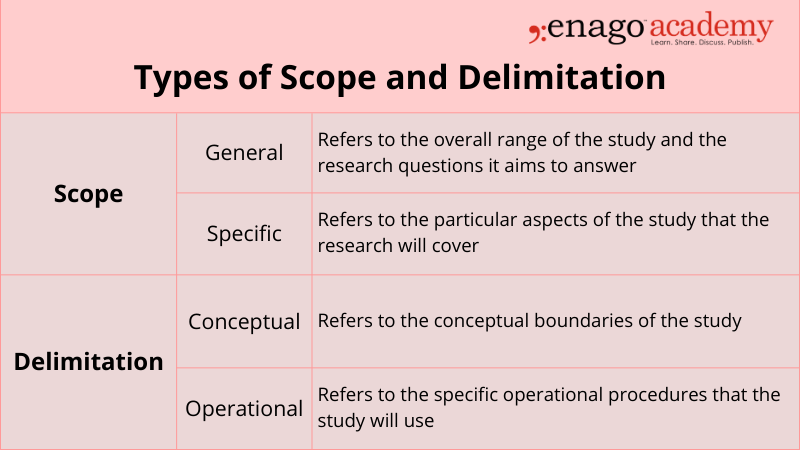- Privacy Policy
Buy Me a Coffee

Home » Delimitations in Research – Types, Examples and Writing Guide

Delimitations in Research – Types, Examples and Writing Guide
Table of Contents

Delimitations
Definition:
Delimitations refer to the specific boundaries or limitations that are set in a research study in order to narrow its scope and focus. Delimitations may be related to a variety of factors, including the population being studied, the geographical location, the time period, the research design , and the methods or tools being used to collect data .
The Importance of Delimitations in Research Studies
Here are some reasons why delimitations are important in research studies:
- Provide focus : Delimitations help researchers focus on a specific area of interest and avoid getting sidetracked by tangential topics. By setting clear boundaries, researchers can concentrate their efforts on the most relevant and significant aspects of the research question.
- Increase validity : Delimitations ensure that the research is more valid by defining the boundaries of the study. When researchers establish clear criteria for inclusion and exclusion, they can better control for extraneous variables that might otherwise confound the results.
- Improve generalizability : Delimitations help researchers determine the extent to which their findings can be generalized to other populations or contexts. By specifying the sample size, geographic region, time frame, or other relevant factors, researchers can provide more accurate estimates of the generalizability of their results.
- Enhance feasibility : Delimitations help researchers identify the resources and time required to complete the study. By setting realistic parameters, researchers can ensure that the study is feasible and can be completed within the available time and resources.
- Clarify scope: Delimitations help readers understand the scope of the research project. By explicitly stating what is included and excluded, researchers can avoid confusion and ensure that readers understand the boundaries of the study.
Types of Delimitations in Research
Here are some types of delimitations in research and their significance:
Time Delimitations
This type of delimitation refers to the time frame in which the research will be conducted. Time delimitations are important because they help to narrow down the scope of the study and ensure that the research is feasible within the given time constraints.
Geographical Delimitations
Geographical delimitations refer to the geographic boundaries within which the research will be conducted. These delimitations are significant because they help to ensure that the research is relevant to the intended population or location.
Population Delimitations
Population delimitations refer to the specific group of people that the research will focus on. These delimitations are important because they help to ensure that the research is targeted to a specific group, which can improve the accuracy of the results.
Data Delimitations
Data delimitations refer to the specific types of data that will be used in the research. These delimitations are important because they help to ensure that the data is relevant to the research question and that the research is conducted using reliable and valid data sources.
Scope Delimitations
Scope delimitations refer to the specific aspects or dimensions of the research that will be examined. These delimitations are important because they help to ensure that the research is focused and that the findings are relevant to the research question.
How to Write Delimitations
In order to write delimitations in research, you can follow these steps:
- Identify the scope of your study : Determine the extent of your research by defining its boundaries. This will help you to identify the areas that are within the scope of your research and those that are outside of it.
- Determine the time frame : Decide on the time period that your research will cover. This could be a specific period, such as a year, or it could be a general time frame, such as the last decade.
- I dentify the population : Determine the group of people or objects that your study will focus on. This could be a specific age group, gender, profession, or geographic location.
- Establish the sample size : Determine the number of participants that your study will involve. This will help you to establish the number of people you need to recruit for your study.
- Determine the variables: Identify the variables that will be measured in your study. This could include demographic information, attitudes, behaviors, or other factors.
- Explain the limitations : Clearly state the limitations of your study. This could include limitations related to time, resources, sample size, or other factors that may impact the validity of your research.
- Justify the limitations : Explain why these limitations are necessary for your research. This will help readers understand why certain factors were excluded from the study.
When to Write Delimitations in Research
Here are some situations when you may need to write delimitations in research:
- When defining the scope of the study: Delimitations help to define the boundaries of your research by specifying what is and what is not included in your study. For instance, you may delimit your study by focusing on a specific population, geographic region, time period, or research methodology.
- When addressing limitations: Delimitations can also be used to address the limitations of your research. For example, if your data is limited to a certain timeframe or geographic area, you can include this information in your delimitations to help readers understand the limitations of your findings.
- When justifying the relevance of the study : Delimitations can also help you to justify the relevance of your research. For instance, if you are conducting a study on a specific population or region, you can explain why this group or area is important and how your research will contribute to the understanding of this topic.
- When clarifying the research question or hypothesis : Delimitations can also be used to clarify your research question or hypothesis. By specifying the boundaries of your study, you can ensure that your research question or hypothesis is focused and specific.
- When establishing the context of the study : Finally, delimitations can help you to establish the context of your research. By providing information about the scope and limitations of your study, you can help readers to understand the context in which your research was conducted and the implications of your findings.
Examples of Delimitations in Research
Examples of Delimitations in Research are as follows:
Research Title : “Impact of Artificial Intelligence on Cybersecurity Threat Detection”
Delimitations :
- The study will focus solely on the use of artificial intelligence in detecting and mitigating cybersecurity threats.
- The study will only consider the impact of AI on threat detection and not on other aspects of cybersecurity such as prevention, response, or recovery.
- The research will be limited to a specific type of cybersecurity threats, such as malware or phishing attacks, rather than all types of cyber threats.
- The study will only consider the use of AI in a specific industry, such as finance or healthcare, rather than examining its impact across all industries.
- The research will only consider AI-based threat detection tools that are currently available and widely used, rather than including experimental or theoretical AI models.
Research Title: “The Effects of Social Media on Academic Performance: A Case Study of College Students”
Delimitations:
- The study will focus only on college students enrolled in a particular university.
- The study will only consider social media platforms such as Facebook, Twitter, and Instagram.
- The study will only analyze the academic performance of students based on their GPA and course grades.
- The study will not consider the impact of other factors such as student demographics, socioeconomic status, or other factors that may affect academic performance.
- The study will only use self-reported data from students, rather than objective measures of their social media usage or academic performance.
Purpose of Delimitations
Some Purposes of Delimitations are as follows:
- Focusing the research : By defining the scope of the study, delimitations help researchers to narrow down their research questions and focus on specific aspects of the topic. This allows for a more targeted and meaningful study.
- Clarifying the research scope : Delimitations help to clarify the boundaries of the research, which helps readers to understand what is and is not included in the study.
- Avoiding scope creep : Delimitations help researchers to stay focused on their research objectives and avoid being sidetracked by tangential issues or data.
- Enhancing the validity of the study : By setting clear boundaries, delimitations help to ensure that the study is valid and reliable.
- Improving the feasibility of the study : Delimitations help researchers to ensure that their study is feasible and can be conducted within the time and resources available.
Applications of Delimitations
Here are some common applications of delimitations:
- Geographic delimitations : Researchers may limit their study to a specific geographic area, such as a particular city, state, or country. This helps to narrow the focus of the study and makes it more manageable.
- Time delimitations : Researchers may limit their study to a specific time period, such as a decade, a year, or a specific date range. This can be useful for studying trends over time or for comparing data from different time periods.
- Population delimitations : Researchers may limit their study to a specific population, such as a particular age group, gender, or ethnic group. This can help to ensure that the study is relevant to the population being studied.
- Data delimitations : Researchers may limit their study to specific types of data, such as survey responses, interviews, or archival records. This can help to ensure that the study is based on reliable and relevant data.
- Conceptual delimitations : Researchers may limit their study to specific concepts or variables, such as only studying the effects of a particular treatment on a specific outcome. This can help to ensure that the study is focused and clear.
Advantages of Delimitations
Some Advantages of Delimitations are as follows:
- Helps to focus the study: Delimitations help to narrow down the scope of the research and identify specific areas that need to be investigated. This helps to focus the study and ensures that the research is not too broad or too narrow.
- Defines the study population: Delimitations can help to define the population that will be studied. This can include age range, gender, geographical location, or any other factors that are relevant to the research. This helps to ensure that the study is more specific and targeted.
- Provides clarity: Delimitations help to provide clarity about the research study. By identifying the boundaries and limitations of the research, it helps to avoid confusion and ensures that the research is more understandable.
- Improves validity: Delimitations can help to improve the validity of the research by ensuring that the study is more focused and specific. This can help to ensure that the research is more accurate and reliable.
- Reduces bias: Delimitations can help to reduce bias by limiting the scope of the research. This can help to ensure that the research is more objective and unbiased.
About the author
Muhammad Hassan
Researcher, Academic Writer, Web developer
You may also like

How to Cite Research Paper – All Formats and...

Data Collection – Methods Types and Examples

Research Paper Format – Types, Examples and...

Research Process – Steps, Examples and Tips

Research Design – Types, Methods and Examples

Institutional Review Board – Application Sample...

Setting Limits and Focusing Your Study: Exploring scope and delimitation
As a researcher, it can be easy to get lost in the vast expanse of information and data available. Thus, when starting a research project, one of the most important things to consider is the scope and delimitation of the study. Setting limits and focusing your study is essential to ensure that the research project is manageable, relevant, and able to produce useful results. In this article, we will explore the importance of setting limits and focusing your study through an in-depth analysis of scope and delimitation.
Company Name 123
Lorem ipsum dolor sit amet, cu usu cibo vituperata, id ius probo maiestatis inciderint, sit eu vide volutpat.
Sign Up for More Insights
Table of Contents
Scope and Delimitation – Definition and difference
Scope refers to the range of the research project and the study limitations set in place to define the boundaries of the project and delimitation refers to the specific aspects of the research project that the study will focus on.
In simpler words, scope is the breadth of your study, while delimitation is the depth of your study.
Scope and delimitation are both essential components of a research project, and they are often confused with one another. The scope defines the parameters of the study, while delimitation sets the boundaries within those parameters. The scope and delimitation of a study are usually established early on in the research process and guide the rest of the project.
Types of Scope and Delimitation

Significance of Scope and Delimitation
Setting limits and focusing your study through scope and delimitation is crucial for the following reasons:
- It allows researchers to define the research project’s boundaries, enabling them to focus on specific aspects of the project. This focus makes it easier to gather relevant data and avoid unnecessary information that might complicate the study’s results.
- Setting limits and focusing your study through scope and delimitation enables the researcher to stay within the parameters of the project’s resources.
- A well-defined scope and delimitation ensure that the research project can be completed within the available resources, such as time and budget, while still achieving the project’s objectives.
5 Steps to Setting Limits and Defining the Scope and Delimitation of Your Study

There are a few steps that you can take to set limits and focus your study.
1. Identify your research question or topic
The first step is to identify what you are interested in learning about. The research question should be specific, measurable, achievable, relevant, and time-bound (SMART). Once you have a research question or topic, you can start to narrow your focus.
2. Consider the key terms or concepts related to your topic
What are the important terms or concepts that you need to understand in order to answer your research question? Consider all available resources, such as time, budget, and data availability, when setting scope and delimitation.
The scope and delimitation should be established within the parameters of the available resources. Once you have identified the key terms or concepts, you can start to develop a glossary or list of definitions.
3. Consider the different perspectives on your topic
There are often different perspectives on any given topic. Get feedback on the proposed scope and delimitation. Advisors can provide guidance on the feasibility of the study and offer suggestions for improvement.
It is important to consider all of the different perspectives in order to get a well-rounded understanding of your topic.
4. Narrow your focus
Be specific and concise when setting scope and delimitation. The parameters of the study should be clearly defined to avoid ambiguity and ensure that the study is focused on relevant aspects of the research question.
This means deciding which aspects of your topic you will focus on and which aspects you will eliminate.
5. Develop the final research plan
Revisit and revise the scope and delimitation as needed. As the research project progresses, the scope and delimitation may need to be adjusted to ensure that the study remains focused on the research question and can produce useful results. This plan should include your research goals, methods, and timeline.
Examples of Scope and Delimitation
To better understand scope and delimitation, let us consider two examples of research questions and how scope and delimitation would apply to them.
Research question: What are the effects of social media on mental health?
Scope: The scope of the study will focus on the impact of social media on the mental health of young adults aged 18-24 in the United States.
Delimitation: The study will specifically examine the following aspects of social media: frequency of use, types of social media platforms used, and the impact of social media on self-esteem and body image.
Research question: What are the factors that influence employee job satisfaction in the healthcare industry?
Scope: The scope of the study will focus on employee job satisfaction in the healthcare industry in the United States.
Delimitation: The study will specifically examine the following factors that influence employee job satisfaction: salary, work-life balance, job security, and opportunities for career growth.
Setting limits and defining the scope and delimitation of a research study is essential to conducting effective research. By doing so, researchers can ensure that their study is focused, manageable, and feasible within the given time frame and resources. It can also help to identify areas that require further study, providing a foundation for future research.
So, the next time you embark on a research project, don’t forget to set clear limits and define the scope and delimitation of your study. It may seem like a tedious task, but it can ultimately lead to more meaningful and impactful research. And if you still can’t find a solution, reach out to Enago Academy using #AskEnago and tag @EnagoAcademy on Twitter , Facebook , and Quora .
Frequently Asked Questions
The scope in research refers to the boundaries and extent of a study, defining its specific objectives, target population, variables, methods, and limitations, which helps researchers focus and provide a clear understanding of what will be investigated.
Delimitation in research defines the specific boundaries and limitations of a study, such as geographical, temporal, or conceptual constraints, outlining what will be excluded or not within the scope of investigation, providing clarity and ensuring the study remains focused and manageable.
To write a scope; 1. Clearly define research objectives. 2. Identify specific research questions. 3. Determine the target population for the study. 4. Outline the variables to be investigated. 5. Establish limitations and constraints. 6. Set boundaries and extent of the investigation. 7. Ensure focus, clarity, and manageability. 8. Provide context for the research project.
To write delimitations; 1. Identify geographical boundaries or constraints. 2. Define the specific time period or timeframe of the study. 3. Specify the sample size or selection criteria. 4. Clarify any demographic limitations (e.g., age, gender, occupation). 5. Address any limitations related to data collection methods. 6. Consider limitations regarding the availability of resources or data. 7. Exclude specific variables or factors from the scope of the study. 8. Clearly state any conceptual boundaries or theoretical frameworks. 9. Acknowledge any potential biases or constraints in the research design. 10. Ensure that the delimitations provide a clear focus and scope for the study.
What is an example of delimitation of the study?
Thank you 💕
Thank You very simplified🩷
Thanks, I find this article very helpful
Rate this article Cancel Reply
Your email address will not be published.

Enago Academy's Most Popular Articles

- Publishing Research
- Reporting Research
How to Optimize Your Research Process: A step-by-step guide
For researchers across disciplines, the path to uncovering novel findings and insights is often filled…

- Industry News
- Trending Now
Breaking Barriers: Sony and Nature unveil “Women in Technology Award”
Sony Group Corporation and the prestigious scientific journal Nature have collaborated to launch the inaugural…

Achieving Research Excellence: Checklist for good research practices
Academia is built on the foundation of trustworthy and high-quality research, supported by the pillars…

- Promoting Research
Plain Language Summary — Communicating your research to bridge the academic-lay gap
Science can be complex, but does that mean it should not be accessible to the…

Science under Surveillance: Journals adopt advanced AI to uncover image manipulation
Journals are increasingly turning to cutting-edge AI tools to uncover deceitful images published in manuscripts.…
Choosing the Right Analytical Approach: Thematic analysis vs. content analysis for…
Research Recommendations – Guiding policy-makers for evidence-based decision making
Demystifying the Role of Confounding Variables in Research

Sign-up to read more
Subscribe for free to get unrestricted access to all our resources on research writing and academic publishing including:
- 2000+ blog articles
- 50+ Webinars
- 10+ Expert podcasts
- 50+ Infographics
- 10+ Checklists
- Research Guides
We hate spam too. We promise to protect your privacy and never spam you.
I am looking for Editing/ Proofreading services for my manuscript Tentative date of next journal submission:

What should universities' stance be on AI tools in research and academic writing?
Scope and Delimitations in Academic Research
Table of contents
- 1.1 Examples of Elements Included in the Scope
- 2.1 Examples of Delimitations in Research
- 3 Determining the Scope and Delimitation
- 4 Writing the Scope and Delimitations Section
- 5 Conclusion
Understanding the scope and delimitations of a study is crucial for defining its parameters and ensuring focused research efforts. What are delimitations in a research study? These components establish the boundaries within which the research will operate and clarify what the study aims to explore and achieve. This article delves into the significance of clearly defining the scope and every delimitation, how they guide the research focus, and their roles in shaping the research process. Additionally, it provides insights into determining these aspects and articulating them effectively in a research proposal or paper. Transitioning smoothly into the main discussion, let’s explore the importance of scope in research, guiding the focus.
The importance of Clearly Defining the Scope of the Study for Guiding Research Focus
The scope of research delineates its extent or range of inquiry, setting clear parameters for what the study will cover. It’s a foundational aspect that guides every step of the research process, from the formulation of research questions to the interpretation of results. Defining the scope helps in focusing the research efforts, ensuring that the study remains manageable and within realistic bounds.
Understanding the scope and limitation of the study allows researchers to allocate resources efficiently, ensuring that every aspect of the study receives adequate attention. It also helps in avoiding the common pitfall of overreaching, which can dilute the research’s impact and make findings less actionable. By setting a defined scope, researchers can more easily communicate their work’s relevance, limitations and delimitations in the research process to stakeholders, enhancing the credibility and applicability of their findings. Furthermore, a well-defined scope can facilitate a more targeted and effective literature review, laying a solid foundation for the research study.
When navigating the complexities of defining a study’s scope, researchers might seek external support to ensure their research is concise, well-structured, and impactful. A writing service , PapersOwl offers a spectrum tailored to meet academic research’s unique demands. Their expertise can be particularly beneficial in refining research proposals, ensuring the scope is clearly communicated and aligned with academic standards. Engaging with such a service allows researchers to benefit from professional insights, which can enhance the coherence and focus of their work. This collaboration can be instrumental in identifying the most relevant study areas and avoiding unnecessary diversions. With PapersOwl’s support, researchers can ensure their project’s scope is well-defined and compellingly presented, making a strong case for its significance and feasibility. This partnership can be a strategic step towards achieving a study’s specific objectives, ensuring it contributes valuable insights within its defined boundaries.
Examples of Elements Included in the Scope
Defining the scope of a research project is akin to drawing a map for a journey; it outlines the terrain to be explored and the boundaries within which the exploration will occur. This clarity is essential for guiding the research process, ensuring the investigation remains focused and relevant. The scope encompasses various elements, each contributing to the overall direction and integrity of the study. Let’s delve into some of these key elements:
- Research Objectives : The specific aim the study is designed to achieve.
- Geographical Coverage: The physical or virtual locations where the research is conducted.
- Time Frame: The period during which the study takes place, which could range from a few days to several years.
- Subject: The specific topics or issues the research intends to address.
- Population Being Studied: The group of individuals, organizations, or phenomena being investigated.
These components of the scope serve as critical navigational tools in the research journey. They ensure that the study remains grounded in its objectives, relevant to its intended audience or population, and manageable within its temporal and geographical constraints. By carefully defining these elements at the outset, researchers can avoid common pitfalls such as scope creep, where the study’s focus broadens uncontrollably, potentially diluting its impact and significance. A well-defined scope is instrumental in crafting a focused, coherent, and impactful research project.
Role of Delimitations in Qualitative Research
Delimitations in research examples specify the boundaries set by the investigator on what the study will not cover, distinguishing them from limitations, which are potential weaknesses in the study not controlled by the researcher. Delimitations are choices made to narrow the scope of a study, focusing on specific aspects while excluding others. In the intricate tapestry of research design, delimitations play a pivotal role in sharpening the focus and enhancing the clarity of a study. By explicitly stating what the research will not explore, delimitations help prevent the dispersion of the research efforts across too broad an area, thereby increasing the depth and specificity of the investigation. This strategic narrowing allows researchers to concentrate their inquiries on areas most likely to yield impactful insights, making efficient use of available resources and time.
One might wonder how to establish these boundaries effectively without compromising the potential breadth of discovery. Here, the expertise provided by platforms like PapersOwl, particularly their research paper help service, becomes invaluable. Their seasoned professionals can offer guidance on crafting a research design that is both focused and flexible, assisting in identifying and justifying delimitations that enhance the study’s relevance and feasibility. Through such collaboration, researchers can balance the scope and delimitation of the study, ensuring that it remains grounded in its objectives while open to unforeseen insights.
Furthermore, acknowledging delimitations in a research paper demonstrates a researcher’s critical understanding of their study’s context and constraints, enhancing the credibility of their work. It shows a mindful engagement with the research process, recognizing that by setting deliberate boundaries, the study can delve more deeply and meaningfully into its chosen area of inquiry. Thus, when thoughtfully articulated with support from research paper writing help, like that offered by PapersOwl, delimitation in research becomes a testament to the rigor and integrity of its effort.
Examples of Delimitations in Research
Delimitations in research are akin to the guardrails on a highway; they keep the investigation on track and prevent it from veering into less relevant or overly broad territories. Below are some examples of how researchers can apply delimitations to fine-tune their investigations:
- Restricting the Study to Certain Age Groups: Focusing on a specific demographic, such as teenagers or the elderly.
- Geographic Locations: Limiting the research to a particular country, city, or region.
- Specific Periods: Studying a phenomenon during a particular time frame, ignoring other periods.
Setting these research delimitations is not about narrowing the vision of the research, but rather about sharpening its focus. It allows for a more thorough and nuanced exploration of the chosen subjects, leading to more precise findings and general delimitation meaning in research. Delimitations highlight the researcher’s awareness of the study’s scope and commitment to conducting a focused, manageable investigation.
Determining the Scope and Delimitation
Identifying the scope and delimitations of your research involves understanding the research problem deeply and recognizing what is feasible within the constraints of time, resources, and data availability. Strategies for determining these include:
- Reviewing existing literature to identify gaps and opportunities.
- Consulting with experts or advisors to refine research questions.
- Considering data availability and methodological constraints.
Balancing the scope and delimitations involves ensuring the research is neither too broad, unmanageable, nor too narrow, limiting its significance. Crafting a research project that strikes the right balance between breadth and depth is a nuanced task. It requires a researcher to be acutely aware of where their study begins and ends, what it encompasses, and what it intentionally leaves out. This equilibrium is not found in isolation but through a diligent exploration of the field and an understanding of how to best position one’s work within it. A key step in this process is identifying and sourcing relevant literature and data, which can significantly influence the scope of research.
Leveraging resources such as PapersOwl’s guide on how to find sources for research papers can prove invaluable in this phase. This platform provides insights into locating credible and relevant information, ensuring that researchers build their work upon a solid foundation of existing knowledge. By understanding how to navigate the vast, effective ocean of available data, researchers can make informed decisions about the direction and limits of their study. This meticulous preparation is crucial for defining the scope and delimitations and justifying them within the context of the research proposal or paper. It demonstrates a researcher’s commitment to rigor and depth, showing that their choices are informed by a comprehensive understanding of the subject and its existing body of literature.
Writing the Scope and Delimitations Section

Articulating the scope and delimitations in a research paper or proposal is crucial for setting clear expectations. It should clearly define delimitations and what the study will and will not cover, providing a rationale for these choices. Effective wording and structure involve:
- Stating the research objectives and questions upfront.
- Describing the research methodology , data collection methods and analysis.
- Outlining the geographical coverage, time frame, and subject matter.
- Clearly stating the delimitations and the reasons behind them.
The presentation of the scope and delimitations within a research document not only guides the readers through the intentions of the research but also establishes a framework for evaluating the findings. It’s a critical section where transparency and precision are paramount, allowing the audience to grasp the extent of the study and the rationale behind its boundaries. This transparency is essential for the credibility of the research, as it demonstrates a conscious and deliberate effort to focus the investigation and acknowledges the existence of boundaries that the study does not cross.
To ensure clarity and impact, this section should seamlessly integrate with the overall narrative of the research proposal or paper. Researchers are advised to avoid jargon and overly technical language, making the research scope and delimitations accessible to a broader audience. This includes a layperson who may not have deep expertise in the field but an interest in the study’s outcomes. Additionally, it is beneficial to highlight how the defined study scope and delimitations contribute to addressing the research problem, filling knowledge gaps, or exploring uncharted territories.
Moreover, this part of the document offers an opportunity to discuss how the chosen delimitations enhance the study’s focus and depth. By justifying the exclusions, researchers can address potential critiques head-on, reinforcing the methodological choices and underscoring the study’s contribution to the field. This careful articulation ensures that the research is perceived as a well-thought-out endeavor, grounded in a strategic approach to inquiry.
The scope and delimitations of a study are foundational elements that guide the research process, setting clear boundaries and focusing efforts. By defining these aspects clearly, researchers can provide a clear roadmap for their investigation, ensuring that their work is both manageable and relevant. By consciously deciding what to exclude from the study, researchers can intensify their focus on the chosen subject, ensuring that the research efforts are concentrated where they are most needed and can be most effective. These self-imposed boundaries are critical for maintaining the study’s coherence and depth. This clarity not only aids in conducting the research but also in effectively communicating its implications, limits, and outcomes.
Readers also enjoyed

WHY WAIT? PLACE AN ORDER RIGHT NOW!
Just fill out the form, press the button, and have no worries!
We use cookies to give you the best experience possible. By continuing we’ll assume you board with our cookie policy.
Research Limitations & Delimitations
What they are and how they’re different (with examples)
By: Derek Jansen (MBA) | Expert Reviewed By: David Phair (PhD) | September 2022
If you’re new to the world of research, you’ve probably heard the terms “ research limitations ” and “ research delimitations ” being thrown around, often quite loosely. In this post, we’ll unpack what both of these mean, how they’re similar and how they’re different – so that you can write up these sections the right way.
Overview: Limitations vs Delimitations
- Are they the same?
- What are research limitations
- What are research delimitations
- Limitations vs delimitations
First things first…
Let’s start with the most important takeaway point of this post – research limitations and research delimitations are not the same – but they are related to each other (we’ll unpack that a little later). So, if you hear someone using these two words interchangeably, be sure to share this post with them!
Research Limitations
Research limitations are, at the simplest level, the weaknesses of the study, based on factors that are often outside of your control as the researcher. These factors could include things like time , access to funding, equipment , data or participants . For example, if you weren’t able to access a random sample of participants for your study and had to adopt a convenience sampling strategy instead, that would impact the generalizability of your findings and therefore reflect a limitation of your study.
Research limitations can also emerge from the research design itself . For example, if you were undertaking a correlational study, you wouldn’t be able to infer causality (since correlation doesn’t mean certain causation). Similarly, if you utilised online surveys to collect data from your participants, you naturally wouldn’t be able to get the same degree of rich data that you would from in-person interviews .
Simply put, research limitations reflect the shortcomings of a study , based on practical (or theoretical) constraints that the researcher faced. These shortcomings limit what you can conclude from a study, but at the same time, present a foundation for future research . Importantly, all research has limitations , so there’s no need to hide anything here – as long as you discuss how the limitations might affect your findings, it’s all good.
Research Delimitations
Alright, now that we’ve unpacked the limitations, let’s move on to the delimitations .
Research delimitations are similar to limitations in that they also “ limit ” the study, but their focus is entirely different. Specifically, the delimitations of a study refer to the scope of the research aims and research questions . In other words, delimitations reflect the choices you, as the researcher, intentionally make in terms of what you will and won’t try to achieve with your study. In other words, what your research aims and research questions will and won’t include.
As we’ve spoken about many times before, it’s important to have a tight, narrow focus for your research, so that you can dive deeply into your topic, apply your energy to one specific area and develop meaningful insights. If you have an overly broad scope or unfocused topic, your research will often pull in multiple, even opposing directions, and you’ll just land up with a muddy mess of findings .
So, the delimitations section is where you’ll clearly state what your research aims and research questions will focus on – and just as importantly, what they will exclude . For example, you might investigate a widespread phenomenon, but choose to focus your study on a specific age group, ethnicity or gender. Similarly, your study may focus exclusively on one country, city or even organization. As long as the scope is well justified (in other words, it represents a novel, valuable research topic), this is perfectly acceptable – in fact, it’s essential. Remember, focus is your friend.
Need a helping hand?
Conclusion: Limitations vs Delimitations
Ok, so let’s recap.
Research limitations and research delimitations are related in that they both refer to “limits” within a study. But, they are distinctly different. Limitations reflect the shortcomings of your study, based on practical or theoretical constraints that you faced.
Contrasted to that, delimitations reflect the choices that you made in terms of the focus and scope of your research aims and research questions. If you want to learn more about research aims and questions, you can check out this video post , where we unpack those concepts in detail.

Psst... there’s more!
This post was based on one of our popular Research Bootcamps . If you're working on a research project, you'll definitely want to check this out ...
You Might Also Like:

18 Comments
Good clarification of ideas on how a researcher ought to do during Process of choice
Thank you so much for this very simple but explicit explanation on limitation and delimitation. It has so helped me to develop my masters proposal. hope to recieve more from your site as time progresses
Thank you for this explanation – very clear.
Thanks for the explanation, really got it well.
This website is really helpful for my masters proposal
Thank you very much for helping to explain these two terms
I spent almost the whole day trying to figure out the differences
when I came across your notes everything became very clear
thanks for the clearly outlined explanation on the two terms, limitation and delimitation.
Very helpful Many thanks 🙏
Excellent it resolved my conflict .
I would like you to assist me please. If in my Research, I interviewed some participants and I submitted Questionnaires to other participants to answered to the questions, in the same organization, Is this a Qualitative methodology , a Quantitative Methodology or is it a Mixture Methodology I have used in my research? Please help me
How do I cite this article in APA format
Really so great ,finally have understood it’s difference now
Getting more clear regarding Limitations and Delimitation and concepts
I really appreciate your apt and precise explanation of the two concepts namely ; Limitations and Delimitations.
This is a good sources of research information for learners.
thank you for this, very helpful to researchers
Very good explained
Great and clear explanation, after a long confusion period on the two words, i can now explain to someone with ease.
Submit a Comment Cancel reply
Your email address will not be published. Required fields are marked *
Save my name, email, and website in this browser for the next time I comment.
- Print Friendly
- Translators
- Graphic Designers
Please enter the email address you used for your account. Your sign in information will be sent to your email address after it has been verified.
Exploring Scope and Delimitation in Academic Research

Academic research is a meticulous process that requires precise planning and clear boundaries. Two pivotal components in this process are the scope and delimitations of the study. The definitions and establishment of these parameters are instrumental in ensuring that the research is effective, manageable, and yields relevant results.
The "scope" of a research project refers to the areas that the study will cover. It is the breadth and depth of the investigation. It defines the subject matter, the geographical location, the time frame, and the issues that the study will explore. Essentially, the scope delineates what the researcher aims to cover in the study.
On the other hand, "delimitations" are the boundaries or limitations set by the researcher. They define what the study will not include. Delimitations could involve the choice of research methodology , the selection of respondents, the duration of the study, and more. They help in confining the study to a manageable size while excluding peripheral elements.
Understanding and correctly implementing scope and delimitations are vital to ensuring your research is well-defined and focused, facilitating higher accuracy and relevancy in your findings.
Importance of scope in research
"Scope" in research refers to the comprehensive extent of study—it outlines the parameters of what will be explored and addressed. It defines the topic of the research , the geographical region under study, the timeframe considered, and the issues that the study will address. The scope of a research project is vital because it determines the depth and breadth of your investigation.
Defining the scope of research is a fundamental step in the research process for several reasons. First, it provides a roadmap for the study, giving the researcher clear guidelines about what to include and exclude. Without a well-defined scope, research can become unmanageably vast or lose its focus.
Second, the scope ensures the research's relevance and applicability. It helps the researcher maintain a tight focus on the study's central question , ensuring that all aspects of the research contribute to answering this question. This focus aids in avoiding irrelevant diversions that could dilute the final conclusions.
Finally, a well-defined scope can help ensure the efficient use of resources. Research involves considerable time, effort, and often financial resources. By providing clear boundaries, the scope ensures these resources are utilized effectively without wasted effort on peripheral issues.
Suppose a research study is looking at the impacts of social media usage on mental health. If the scope is too broad—like examining all social media platforms' effects on all demographic groups worldwide—then the research can quickly become unwieldy and hard to manage. It would involve vast amounts of data, requiring considerable time, resources, and computational power to analyze effectively.
However, if the scope is narrowed down—such as investigating the impact of Instagram usage on the mental health of teenagers in a specific city over the past five years—the research becomes far more manageable. This specific focus allows for a more in-depth analysis and likely will provide more meaningful, actionable results. This example illustrates the importance of appropriately defining the scope of research for its successful execution.
Determining the scope of your research
Setting the scope of your research project is a critical and delicate task. Below are steps, tips, and common mistakes to avoid when determining the scope of your research:
Steps to define the scope
- Identify Your Topic: The first step involves identifying and understanding your research topic. This knowledge will serve as a basis for determining the breadth and depth of your study.
- Define Your Research Questions: The research questions are the heart of your study. They will help you determine the specific areas your research should cover.
- Establish Boundaries: Clearly establish the geographical, temporal, and topical boundaries of your research. These boundaries will guide the range of your study.
- Choose Your Methodology: Decide on the research methods you will use as these will directly impact the scope of your study.
Tips for a manageable scope
- Stay Focused: Stay concentrated on your research questions. Do not stray into areas that aren't directly relevant.
- Be Realistic: Consider the resources (time, money, manpower) available. Ensure your scope is feasible given these resources.
- Seek Guidance: Consult with your academic advisor or peers for feedback on your proposed scope.
Common mistakes to avoid
- Overly Broad Scope: Avoid setting an overly broad scope which could result in an unmanageable and unfocused study.
- Too Narrow Scope: Conversely, a scope that is too narrow may miss important aspects of the research topic.
- Ignoring Resources: Not taking into account available resources when setting the scope can lead to a project that is impossible to complete.
Defining the scope of your research is a delicate balance, requiring careful consideration of your research questions, resources, and the depth and breadth of investigation needed to answer these questions effectively.
Importance of delimitations in research
In the context of academic research, "delimitations" refers to the choices made by the researcher which define the boundaries of the study. These are the variables that lead the researcher to narrow the scope of the study from its potential vastness to a manageable size.
Delimitations might include the geographic area where the study is confined, the participants involved in the study, the methodology used, the time period considered, or the specific incidents or aspects the study will focus on. Essentially, delimitations are the self-imposed limitations on the scope of the study.
Defining the delimitations of a research project is crucial for several reasons. Firstly, they establish the context or setting in which the study occurs. This, in turn, allows for the work to be reproduced in a similar context for verification or refutation in future studies.
Secondly, delimitations provide a way to narrow the scope of the research to a manageable size, thus avoiding the pitfall of an overly ambitious project. They help researchers to stay focused on the main research questions and prevent diversion into irrelevant aspects.
Finally, clearly defined delimitations enhance the credibility of the research. They offer transparency about the research design and methodology, which adds to the validity of the results.
For instance, in a research study examining the impact of technology on student achievement in a certain district, examples of delimitations might include focusing only on public schools, considering only high school students, and confining the study to a particular school year. These choices help to focus the research and ensure its manageability. Therefore, delimitations play a pivotal role in structuring and guiding an effective and efficient research study.
Setting delimitations for your research
Establishing appropriate delimitations for your research project is an important part of research design. Here are some steps, guidelines, and common mistakes to consider when setting your research delimitations:
Steps to establish delimitations
- Identify the boundaries: Begin by deciding the geographical region, time period, and subject matter your research will cover.
- Determine Your Research Population: Identify the specific population your study will focus on. This could be based on age, profession, geographical location, etc.
- Choose Your Research Methods: Decide the specific methods you will use to collect and analyze data, as these decisions will also set limitations on your study.
Guidelines for choosing delimitations
- Align with Your Research Objectives: The delimitations should be in line with your research questions and objectives. They should help focus your study without detracting from its goals.
- Be Practical: Consider the resources available, including time, funds, and access to data. Your delimitations should be feasible given these constraints.
- Seek Input: Consult with your research advisor or peers. Their feedback can help ensure your delimitations are appropriate and well thought out.
Common errors to avoid:
- Unrealistic Delimitations: Be wary of setting delimitations that are too stringent or ambitious to be feasible given your resources and timeframe.
- Undefined Delimitations: Avoid leaving your delimitations vague or undefined. This can lead to scope creep, where your project expands beyond its initial plan, making it unmanageable.
- Ignoring Delimitations: Once set, stick to your delimitations. Deviating from them can lead to a loss of focus and can compromise the integrity of your results.
Setting delimitations is a crucial step in research planning. Properly defined delimitations can make your research project more manageable, maintain your focus, and ensure the effective use of your resources.
The interplay between scope and delimitations
The relationship between scope and delimitations in academic research is a dynamic and interdependent one. Each aspect serves to shape and refine the other, ultimately leading to a focused, feasible, and effective research design.
The scope of a research project describes the breadth and depth of the investigation—what it aims to cover and how far it intends to delve into the subject matter. The delimitations, on the other hand, identify the boundaries and constraints of the study—what it will not cover.
As such, the scope and delimitations of a research study are intimately connected. When the scope of a study is broad, the delimitations must be carefully considered to ensure the project remains manageable and focused. Conversely, when the scope is narrow, the delimitations might be less constraining, but they still play a critical role in defining the specificity of the research.
Balancing the scope and delimitations is crucial for an efficient research design. Too broad a scope without carefully defined delimitations can lead to a study that is unwieldy and lacks depth. On the other hand, a very narrow scope with overly rigid delimitations might result in a study that overlooks important aspects of the research topic.
Thus, researchers must strive to maintain a balance—establishing a scope that is wide enough to fully explore the research topic, but also setting appropriate delimitations to ensure the study remains feasible and focused. In doing so, the research will be well-structured and yield meaningful, relevant findings.
Role of scope and delimitations in research validity
Scope and delimitations are fundamental aspects of research design that directly influence the validity, reliability, and replicability of a study.
Research validity refers to the degree to which a study accurately reflects or measures the concept that the researcher intends to investigate. A well-defined scope is critical to research validity because it clearly delineates what the study will cover. This clear definition ensures that the research focuses on relevant aspects of the topic and that the findings accurately reflect the concept under investigation.
Similarly, carefully thought-out delimitations contribute to research validity by identifying what the study will not cover. This clarity helps to prevent the study from straying into irrelevant areas, ensuring that the research stays focused and relevant.
In addition to contributing to research validity, scope and delimitations also influence the reliability and replicability of a study. Reliability refers to the consistency of a study's results, while replicability refers to the ability of other researchers to repeat the study and obtain similar results.
A clearly defined scope makes a study more reliable by providing a detailed outline of the areas covered by the research. This clarity makes it more likely that the study will produce consistent results. Moreover, clearly defined delimitations enhance the replicability of a study by providing explicit boundaries for the research, which makes it easier for other researchers to repeat the study in a similar context.
In summary, a well-defined scope and carefully thought-out delimitations contribute significantly to the validity, reliability, and replicability of academic research. They ensure that the research is focused, that the findings are relevant and accurate, and that the study can be reliably repeated by other researchers.
Examples of scope and delimitation in well-known research
- The Milgram Experiment: Stanley Milgram's famous psychology experiment sought to understand obedience to authority figures. The scope of this study was clearly defined—it focused on how far individuals would go in obeying an instruction if it involved harming another person. However, delimitations were set to ensure manageability. Participants were delimited to male individuals, and the experiment was confined to a controlled laboratory setting. These delimitations allowed Milgram to manage the research effectively while maintaining the depth of his study on human behavior.
- The Framingham Heart Study: This ongoing cardiovascular study began in 1948 and is aimed at identifying common factors that contribute to cardiovascular disease. The scope of the research is broad, covering many aspects of lifestyle, medical history, and physical characteristics. However, the study set clear delimitations: it initially only involved adult residents of Framingham, Massachusetts. This geographical delimitation made this broad-scope study manageable and eventually yielded influential results that shaped our understanding of heart disease.
- The Marshmallow Test: This well-known study by Walter Mischel explored delayed gratification in children. The scope was clearly defined: the study aimed to understand the ability of children to delay gratification and how it related to future success. The delimitations of the study included the age of the participants (preschool children), the setting (a controlled experiment with a treat), and the measure of future success (academic achievement, ability to cope with stress, etc.). These delimitations helped keep the study focused and manageable.
In all these examples, the researchers set a clear scope to outline the focus of their studies and used delimitations to restrict the boundaries. This balance between scope and delimitation was key in conducting successful and influential research.
In academic research, defining the scope and delimitations is a pivotal step in designing a robust and effective study. The scope outlines the breadth and depth of the investigation, offering a clear direction for the research. Meanwhile, delimitations set the boundaries of the study, ensuring that the research remains focused and manageable. Together, they play a crucial role in enhancing the validity, reliability, and replicability of a study.
Understanding the interplay between scope and delimitations is key to conducting efficient research. A well-defined scope paired with thoughtfully set delimitations contribute to a study's feasibility and its potential to yield meaningful and applicable results. Mistakes in setting the scope and delimitations can lead to unwieldy, unfocused research or a study that overlooks important aspects of a research question.
Reviewing famous studies, like the Milgram Experiment, the Framingham Heart Study, and the Marshmallow Test, we observe how a balanced approach to setting scope and delimitations can result in influential and valuable findings. Therefore, researchers should give careful thought to defining the scope and delimitations of their studies, keeping in mind their research questions, available resources, and the need for balance between breadth and focus. By doing so, they pave the way for successful and impactful research outcomes.
Header image by Kübra Arslaner .
Related Posts

How Does a Hypothesis Differ From a Research Question?

How to Order and Format Author Names in Scientific Papers
- Academic Writing Advice
- All Blog Posts
- Writing Advice
- Admissions Writing Advice
- Book Writing Advice
- Short Story Advice
- Employment Writing Advice
- Business Writing Advice
- Web Content Advice
- Article Writing Advice
- Magazine Writing Advice
- Grammar Advice
- Dialect Advice
- Editing Advice
- Freelance Advice
- Legal Writing Advice
- Poetry Advice
- Graphic Design Advice
- Logo Design Advice
- Translation Advice
- Blog Reviews
- Short Story Award Winners
- Scholarship Winners

Need an academic editor before submitting your work?

Diving Deeper into Limitations and Delimitations

If you are working on a thesis, dissertation, or other formal research project, chances are your advisor or committee will ask you to address the delimitations of your study. When faced with this request, many students respond with a puzzled look and then go on to address what are actually the study’s limitations.
In a previous article , we covered what goes into the limitations, delimitations, and assumptions sections of your thesis or dissertation. Here, we will dive a bit deeper into the differences between limitations and delimitations and provide some helpful tips for addressing them in your research project—whether you are working on a quantitative or qualitative study.
Acknowledging Weaknesses vs. Defining Boundaries
These concepts are easy to get confused because both limitations and delimitations restrict (or limit) the questions you’ll be able to answer with your study, most notably in terms of generalizability.
However, the biggest difference between limitations and delimitations is the degree of control you have over them—that is, how much they are based in conscious, intentional choices you made in designing your study.
Limitations occur in all types of research and are, for the most part, outside the researcher’s control (given practical constraints, such as time, funding, and access to populations of interest). They are threats to the study’s internal or external validity.
Limitations may include things such as participant drop-out, a sample that isn’t entirely representative of the desired population, violations to the assumptions of parametric analysis (e.g., normality, homogeneity of variance), the limits of self-report, or the absence of reliability and validity data for some of your survey measures.
Limitations can get in the way of your being able to answer certain questions or draw certain types of inferences from your findings. Therefore, it’s important to acknowledge them upfront and make note of how they restrict the conclusions you’ll be able to draw from your study. Frequently, limitations can get in the way of our ability to generalize our findings to the larger populations or to draw causal conclusions, so be sure to consider these issues when you’re thinking about the potential limitations of your study.
Delimitations are also factors that can restrict the questions you can answer or the inferences you can draw from your findings. However, they are based on intentional choices you make a priori (i.e., as you’re designing the study) about where you’re going to draw the boundaries of your project. In other words, they define the project’s scope.
Like limitations, delimitations are a part of every research project, and this is not a bad thing. In fact, it’s very important! You can’t study everything at once. If you try to do so, your project is bound to get huge and unwieldy, and it will become a lot more difficult to interpret your results or come to meaningful conclusions with so many moving parts. You have to draw the line somewhere, and the delimitations are where you choose to draw these lines.
One of the clearest examples of a delimitation that applies to almost every research project is participant exclusion criteria. In conducting either a quantitative or a qualitative study, you will have to define your population of interest. Defining this population of interest means that you will need to articulate the boundaries of that population (i.e., who is not included). Those boundaries are delimitations.
For example, if you’re interested in understanding the experiences of elementary school teachers who have been implementing a new curriculum into their classrooms, you probably won’t be interviewing or sending a survey to any of the following people: non-teachers, high-school teachers, college professors, principals, parents of elementary school children, or the children themselves. Furthermore, you probably won’t be talking to elementary school teachers who have not yet had the experience of implementing the curriculum in question. You would probably only choose to gather data from elementary school teachers who have had this experience because that is who you’re interested in for the purposes of your study. Perhaps you’ll narrow your focus even more to elementary school teachers in a particular school district who have been teaching for a particular length of time. The possibilities can go on. These are choices you will need to make, both for practical reasons (i.e., the population you have access to) and for the questions you are trying to answer.
Of course, for this particular example, this does not mean that it wouldn’t be interesting to also know what principals think about the new curriculum. Or parents. Or elementary school children. It just means that, for the purposes of your project and your research questions, you’re interested in the experience of the teachers, so you’re excluding anyone who does not meet those criteria. Having delimitations to your population of interest also means that you won’t be able to answer any questions about the experiences of those other populations; this is ok because those populations are outside of the scope of your project . As interesting as their experiences might be, you can save these questions for another study. That is the part of the beauty of research: there will always be more studies to do, more questions to ask. You don’t have to (and can’t) do it all in one project.
Continuing with the previous example, for instance, let’s suppose that the problem you are most interested in addressing is the fact that we know relatively little about elementary school teachers’ experiences of implementing a new curriculum. Perhaps you believe that knowing more about teachers’ experiences could inform their training or help administrators know more about how to support their teachers. If the identified problem is our lack of knowledge about teachers’ experiences, and your research questions focus on better understanding these experiences, that means that you are choosing not to focus on other problems or questions, even those that may seem closely related. For instance, you are not asking how effective the new curriculum is in improving student test scores or graduation rates. You might think that would be a very interesting question, but it will have to wait for another study. In narrowing the focus of your research questions, you limit your ability to answer other questions, and again, that’s ok. These other questions may be interesting and important, but, again, they are beyond the scope of your project .
Common Examples of Limitations
While each study will have its own unique set of limitations, some limitations are more common in quantitative research, and others are more common in qualitative research.
In quantitative research, common limitations include the following:
– Participant dropout
– Small sample size, low power
– Non-representative sample
– Violations of statistical assumptions
– Non-experimental design, lack of manipulation of variables, lack of controls
– Potential confounding variables
– Measures with low (or unknown) reliability or validity
– Limits of an instrument to measure the construct of interest
– Data collection methods (e.g., self-report)
– Anything else that might limit the study’s internal or external validity
In qualitative research, common limitations include the following:
– Lack of generalizability of findings (not the goal of qualitative research, but still worth mentioning as a limitation)
– Inability to draw causal conclusions (again, not the goal of qualitative research, but still worth mentioning)
– Researcher bias/subjectivity (especially if there is only one coder)
– Limitations in participants’ ability/willingness to share or describe their experiences
– Any factors that might limit the rigor of data collection or analysis procedures
Common Examples of Delimitations
As noted above, the two most common sources of delimitations in both quantitative and qualitative research include the following:
– Inclusion/exclusion criteria (or how you define your population of interest)
– Research questions or problems you’ve chosen to examine
Several other common sources of delimitations include the following:
– Theoretical framework or perspective adopted
– Methodological framework or paradigm chosen (e.g., quantitative, qualitative, or mixed-methods)
– In quantitative research, the variables you’ve chosen to measure or manipulate (as opposed to others)
Whether you’re conducting a quantitative or qualitative study, you will (hopefully!) have chosen your research design because it is well suited to the questions you’re hoping to answer. Because these questions define the boundaries or scope of your project and thus point to its delimitations, your research design itself will also be related to these delimitations.
Questions to Ask Yourself
As you are considering the limitations and delimitations of your project, it can be helpful to ask yourself a few different questions.
Questions to help point out your study’s limitations :
1. If I had an unlimited budget, unlimited amounts of time, access to all possible populations, and the ability to manipulate as many variables as I wanted, how would I design my study differently to be better able to answer the questions I want to answer? (The ways in which your study falls short of this will point to its limitations.)
2. Are there design issues that get in the way of my being able to draw causal conclusions?
3. Are there sampling issues that get in the way of my being able to generalize my findings?
4. Are there issues related to the measures I’m using or the methods I’m using to collect data? Do I have concerns about participants telling the truth or being able to provide accurate responses to my questions?
5. Are there any other factors that might limit my study’s internal or external validity?
Questions that help point out your study’s delimitations :
1. What are my exclusion criteria? Who did I not include in my study, and why did I make this choice?
2. What questions did I choose not to address in my study? (Of course, the possibilities are endless here, but consider related questions that you chose not to address.)
3. In what ways did I narrow the scope of my study in order to hone in on a particular issue or question?
4. What other methodologies did I not use that might have allowed me to answer slightly different questions about the same topic?
How to Write About Limitations and Delimitations
Remember, having limitations and delimitations is not a bad thing. They’re present in even the most rigorous research. The important thing is to be aware of them and to acknowledge how they may impact your findings or the conclusions you can draw.
In fact, writing about them and acknowledging them gives you an opportunity to demonstrate that you can think critically about these aspects of your study and how they impact your findings, even if they were out of your control.
Keep in mind that your study’s limitations will likely point to important directions for future research. Therefore, when you’re getting ready to write about your recommendations for future research in your discussion, remember to refer back to your limitations section!
As you write about your delimitations in particular, remember that they are not weaknesses, and you don’t have to apologize for them. Good, strong research projects have clear boundaries. Also, keep in mind that you are the researcher and you can choose whatever delimitations you want for your study. You’re in control of the delimitations. You just have to be prepared—both in your discussion section and in your dissertation defense itself—to justify the choices you make and acknowledge how these choices impact your findings.
Browse More on PhDStudent

Everything You Need to Know About References and Citations: Part 1
When you conduct your research, it is important to record the details of all the information you find to provide accurate references, …

How to Write a Proposal: For a Master’s Thesis or Dissertation
Note: Many thanks to fellow PhDStudent blogger Ryan Krone for his contributions and insight to this post. Your thesis/dissertation proposal provides an …

How to Find Free Money for Graduate School Part 2
Getting into graduate school is already a challenge on its own, and funding the program once admitted is even harder. Graduate studies …

How to Find Free Money for Graduate School
You’ve finally earned your Bachelor’s degree and have made it into graduate school. Whether you already have massive student loans from undergrad …

Part 3 of How to Pick Your Defense Committee
What strategies can a doctoral student employ to maneuver the trials and tribulations of a dissertation committee? In Part 2, we …

Best Dissertation Proofreading and Editing Tips to Make Your Work Spotless
You’ve heard this statement many times before: “the dissertation is the most important project you’ve ever worked on.” That may sound like …

Part 2 of How to Pick Your Defense Committee
Choosing a committee can be a daunting task for a doctoral student. We’ve already covered two strategies that can help you through this …

Part 1 of How to Pick Your Defense Committee
So you’re ready to pick your committee members; there are a few things to keep in mind first—after all, it is a …

Intro To Series on How to Pick Your Defense Committee
Choosing the right defense committee can potentially be the difference between a smooth transition of receiving your doctoral degree or dodging bullets …

On Babies and Dissertations: Part 3
I recently had the experience of expecting my first baby a month before I graduated. Throughout the process, I accidentally learned several …

On Babies and Dissertations: Part 2

On Babies and Dissertations: Part 1
I recently had the experience of expecting my first baby a month before I graduated and accidentally learned tips on graduating on time with a …
Click here to cancel reply.
You must be logged in to post a comment.
Copyright © 2024 PhDStudent.com. All rights reserved. Designed by Divergent Web Solutions, LLC .

Community Blog
Keep up-to-date on postgraduate related issues with our quick reads written by students, postdocs, professors and industry leaders.
How to Write the Scope of the Study
- By DiscoverPhDs
- August 26, 2020

What is the Scope of the Study?
The scope of the study refers to the boundaries within which your research project will be performed; this is sometimes also called the scope of research. To define the scope of the study is to define all aspects that will be considered in your research project. It is also just as important to make clear what aspects will not be covered; i.e. what is outside of the scope of the study.
Why is the Scope of the Study Important?
The scope of the study is always considered and agreed upon in the early stages of the project, before any data collection or experimental work has started. This is important because it focuses the work of the proposed study down to what is practically achievable within a given timeframe.
A well-defined research or study scope enables a researcher to give clarity to the study outcomes that are to be investigated. It makes clear why specific data points have been collected whilst others have been excluded.
Without this, it is difficult to define an end point for a research project since no limits have been defined on the work that could take place. Similarly, it can also make the approach to answering a research question too open ended.
How do you Write the Scope of the Study?
In order to write the scope of the study that you plan to perform, you must be clear on the research parameters that you will and won’t consider. These parameters usually consist of the sample size, the duration, inclusion and exclusion criteria, the methodology and any geographical or monetary constraints.
Each of these parameters will have limits placed on them so that the study can practically be performed, and the results interpreted relative to the limitations that have been defined. These parameters will also help to shape the direction of each research question you consider.
The term limitations’ is often used together with the scope of the study to describe the constraints of any parameters that are considered and also to clarify which parameters have not been considered at all. Make sure you get the balance right here between not making the scope too broad and unachievable, and it not being too restrictive, resulting in a lack of useful data.
The sample size is a commonly used parameter in the definition of the research scope. For example, a research project involving human participants may define at the start of the study that 100 participants will be recruited. This number will be determined based on an understanding of the difficulty in recruiting participants to studies and an agreement of an acceptable period of time in which to recruit this number.
Any results that are obtained by the research group can then be interpreted by others with the knowledge that the study was capped to 100 participants and an acceptance of this as a limitation of the study. In other words, it is acknowledged that recruiting 100 rather than 1,000 participants has limited the amount of data that could be collected, however this is an acceptable limitation due to the known difficulties in recruiting so many participants (e.g. the significant period of time it would take and the costs associated with this).
Example of a Scope of the Study
The follow is a (hypothetical) example of the definition of the scope of the study, with the research question investigating the impact of the COVID-19 pandemic on mental health.
Whilst the immediate negative health problems related to the COVID-19 pandemic have been well documented, the impact of the virus on the mental health (MH) of young adults (age 18-24 years) is poorly understood. The aim of this study is to report on MH changes in population group due to the pandemic.
The scope of the study is limited to recruiting 100 volunteers between the ages of 18 and 24 who will be contacted using their university email accounts. This recruitment period will last for a maximum of 2 months and will end when either 100 volunteers have been recruited or 2 months have passed. Each volunteer to the study will be asked to complete a short questionnaire in order to evaluate any changes in their MH.
From this example we can immediately see that the scope of the study has placed a constraint on the sample size to be used and/or the time frame for recruitment of volunteers. It has also introduced a limitation by only opening recruitment to people that have university emails; i.e. anyone that does not attend university will be excluded from this study.
This may be an important factor when interpreting the results of this study; the comparison of MH during the pandemic between those that do and do not attend university, is therefore outside the scope of the study here. We are also told that the methodology used to assess any changes in MH are via a questionnaire. This is a clear definition of how the outcome measure will be investigated and any other methods are not within the scope of research and their exclusion may be a limitation of the study.
The scope of the study is important to define as it enables a researcher to focus their research to within achievable parameters.

Learn 10 ways to impress a PhD supervisor for increasing your chances of securing a project, developing a great working relationship and more.

The purpose of research is to enhance society by advancing knowledge through developing scientific theories, concepts and ideas – find out more on what this involves.

A well written figure legend will explain exactly what a figure means without having to refer to the main text. Our guide explains how to write one.
Join thousands of other students and stay up to date with the latest PhD programmes, funding opportunities and advice.

Browse PhDs Now

PhD stress is real. Learn how to combat it with these 5 tips.

Stay up to date with current information being provided by the UK Government and Universities about the impact of the global pandemic on PhD research studies.

Lewis is a third-year PhD student at CVSSP at the University of Surrey. His research involves using multi-camera broadcast footage of sports, and using this data to create new viewpoints in virtual and augmented reality.

Kat is in the second year of her PhD at the International Centre for Radio Astronomy Research (ICRAR) in Perth, Western Australia (WA). Her research involves studying supermassive black holes at the centres of distant galaxies.
Join Thousands of Students
How To Write Scope and Delimitation of a Research Paper (With Examples)

An effective research paper or thesis has a well-written Scope and Delimitation. This portion specifies your study’s coverage and boundaries.
Not yet sure about how to write your research’s Scope and Delimitation? Fret not, as we’ll guide you through the entire writing process through this article.
Related: How To Write Significance of the Study (With Examples)
Table of Contents
What is the scope and delimitation of a research paper.

The “Scope and Delimitation” section states the concepts and variables your study covered. It tells readers which things you have included and excluded in your analysis.
This portion tells two things: 1
- The study’s “Scope” – concepts and variables you have explored in your research and;
- The study’s “Delimitation” – the “boundaries” of your study’s scope. It sets apart the things included in your analysis from those excluded.
For example, your scope might be the effectiveness of plant leaves in lowering blood sugar levels. You can “delimit” your study only to the effect of gabi leaves on the blood glucose of Swiss mice.
Where Should I Put the Scope and Delimitation?
This portion is in Chapter 1, usually after the “Background of the Study.”
Why Should I Write the Scope and Delimitation of My Research Paper?
There’s a lot to discover in a research paper or thesis. However, your resources and time dedicated to it are scarce. Thus, given these constraints, you have to narrow down your study. You do this in the Scope and Delimitation.
Suppose you’re studying the correlation between the quantity of organic fertilizer and plant growth . Experimenting with several types of plants is impossible because of several limitations. So, you’ve decided to use one plant type only.
Informing your readers about this decision is a must. So, you have to state it in your Scope and Delimitation. It also acts as a “disclaimer” that your results are inapplicable to the entire plant kingdom.
What Is the Difference Between Delimitation and Limitation?

People often use the terms “Delimitation” and “Limitation” interchangeably. However, these words differ 2 .
Delimitation refers to factors you set to limit your analysis. It delineates those that are included in your research and those that are excluded. Remember, delimitations are within your control.
Meanwhile, limitations are factors beyond your control that may affect your research’s results. You can think of limitations as the “weaknesses” of your study.
Let’s go back to our previous example. Due to some constraints, you’ve only decided to examine one plant type: dandelions. This is an example of a delimitation since it limits your analysis to dandelions only and not other plant types. Note that the number of plant types used is within your control.
Meanwhile, your study cannot state that a higher quantity of organic fertilizer is the sole reason for plant growth. That’s because your research’s focus is only on correlation. Since this is already beyond your control, then this is a limitation.
How To Write Scope and Delimitation: Step-by-Step Guide
To write your research’s Scope and Delimitation section, follow these steps:
1. Review Your Study’s Objectives and Problem Statement

Your study’s coverage relies on its objectives. Thus, you can only write this section if you know what you’re researching. Furthermore, ensure that you understand the problems you ought to answer.
Once you understand the abovementioned things, you may start writing your study’s Scope and Delimitation.
2. State the Key Information To Explain Your Study’s Coverage and Boundaries

a. The Main Objective of the Research
This refers to the concept that you’re focusing on in your research. Some examples are the following:
- level of awareness or satisfaction of a particular group of people
- correlation between two variables
- effectiveness of a new product
- comparison between two methods/approaches
- lived experiences of several individuals
It’s helpful to consult your study’s Objectives or Statement of the Problem section to determine your research’s primary goal.
b. Independent and Dependent Variables Included
Your study’s independent variable is the variable that you manipulate. Meanwhile, the dependent variable is the variable whose result depends upon the independent variable. Both of these variables must be clear and specific when indicated.
Suppose you study the relationship between social media usage and students’ language skills. These are the possible variables for the study:
- Independent Variable: Number of hours per day spent on using Facebook
- Dependent Variable: Grade 10 students’ scores in Quarterly Examination in English.
Note how specific the variables stated above are. For the independent variable, we narrow it down to Facebook only. Since there are many ways to assess “language skills,” we zero in on the students’ English exam scores as our dependent variable.
c. Subject of the Study
This refers to your study’s respondents or participants.
In our previous example, the research participants are Grade 10 students. However, there are a lot of Grade 10 students in the Philippines. Thus, we have to select from a specific school only—for instance, Grade 10 students from a national high school in Manila.
d. Timeframe and Location of the Study
Specify the month(s), quarter(s), or year(s) as the duration of your study. Also, indicate where you will gather the data required for your research.
e. Brief Description of the Study’s Research Design and Methodology
You may also include whether your research is quantitative or qualitative, the sampling method (cluster, stratified, purposive) applied, and how you conducted the experiment.
Using our previous example, the Grade 10 students can be selected using stratified sampling. Afterward, the researchers may obtain their English quarterly exam scores from their respective teachers. You can add these things to your study’s Scope and Delimitation.
3. Indicate Which Variables or Factors Are Not Covered by Your Research

Although you’ve already set your study’s coverage and boundaries in Step 2, you may also explicitly mention things you’ve excluded from your research.
Returning to our previous example, you can state that your assessment will not include the vocabulary and oral aspects of the English proficiency skill.
Examples of Scope and Delimitation of a Research Paper
1. scope and delimitation examples for quantitative research.

a. Example 1
Research Title
A Study on the Relationship of the Extent of Facebook Usage on the English Proficiency Level of Grade 10 Students of Matagumpay High School
Scope and Delimitation
(Main Objective)
This study assessed the correlation between the respondents’ duration of Facebook usage and their English proficiency level.
(Variables used)
The researchers used the number of hours per day of using Facebook and the activities usually performed on the platform to assess the respondents’ extent of Facebook usage. Meanwhile, the respondents’ English proficiency level is limited to their quarterly English exam scores.
(Subject of the study)
A sample of fifty (50) Grade 10 students of Matagumpay High School served as the study’s respondents.
(Timeframe and location)
This study was conducted during the Second Semester of the School Year 2018 – 2019 on the premises of Matagumpay High School in Metro Manila.
(Methodology)
The respondents are selected by performing stratified random sampling to ensure that there will be ten respondents from five Grade 10 classes of the school mentioned above. The researchers administered a 20-item questionnaire to assess the extent of Facebook usage of the selected respondents. Meanwhile, the data for the respondents’ quarterly exam scores were acquired from their English teachers. The collected data are handled with the utmost confidentiality. Spearman’s Rank Order Correlation was applied to quantitatively assess the correlation between the variables.
(Exclusions)
This study didn’t assess other aspects of the respondents’ English proficiency, such as English vocabulary and oral skills.
Note: The words inside the parentheses in the example above are guides only. They are not included in the actual text.
b. Example 2
Level of Satisfaction of Grade 11 Students on the Implementation of the Online Learning Setup of Matagumpay High School for SY 2020 – 2021
This study aims to identify students’ satisfaction levels with implementing online learning setups during the height of the COVID-19 pandemic.
Students’ satisfaction was assessed according to teachers’ pedagogy, school policies, and learning materials used in the online learning setup. The respondents included sixty (60) Grade 11 students of Matagumpay High School who were randomly picked. The researchers conducted the study from October 2020 to February 2021.
Online platforms such as email and social media applications were used to reach the respondents. The researchers administered a 15-item online questionnaire to measure the respondents’ satisfaction levels. Each response was assessed using a Likert Scale to provide a descriptive interpretation of their answers. A weighted mean was applied to determine the respondents’ general satisfaction.
This study did not cover other factors related to the online learning setup, such as the learning platform used, the schedule of synchronous learning, and channels for information dissemination.
2. Scope and Delimitation Examples for Qualitative Research

Lived Experiences of Public Utility Vehicle (PUV) Drivers of Antipolo City Amidst the Continuous June 2022 Oil Price Hikes
This research focused on the presentation and discussion of the lived experiences of PUV drivers during the constant oil price hike in June 2022.
The respondents involved are five (5) jeepney drivers from Antipolo City who agreed to be interviewed. The researchers assessed their experiences in terms of the following: (1) daily net income; (2) duration and extent of working; (3) alternative employment opportunity considerations; and (4) mental and emotional status. The respondents were interviewed daily at their stations on June 6 – 10, 2022.
In-depth one-on-one interviews were used for data collection. Afterward, the respondents’ first-hand experiences were drafted and annotated with the researchers’ insights.
The researchers excluded some factors in determining the respondents’ experiences, such as physical and health conditions and current family relationship status.
A Study on the Perception of the Residents of Mayamot, Antipolo City on the Political and Socioeconomic Conditions During the Post-EDSA Period (1986 – 1996)
This research aims to discuss the perception of Filipinos regarding the political and socioeconomic economic conditions during the post-EDSA period, specifically during the years 1986 – 1996.
Ten (10) residents of Mayamot, Antipolo City, who belonged to Generation X (currently 40 – 62 years old), were purposively selected as the study’s respondents. The researchers asked them about their perception of the following aspects during the period mentioned above (1) performance of national and local government; (2) bureaucracy and government services; (3) personal economic and financial status; and (4) wage purchasing power.
The researchers conducted face-to-face interviews in the respondents’ residences during the second semester of AY 2018 – 2019. The responses were written and corroborated with the literature on the post-EDSA period.
The following factors were not included in the research analysis: political conflicts and turmoils, the status of the legislative and judicial departments, and other macroeconomic indicators.
Tips and Warnings
1. use the “5ws and 1h” as your guide in understanding your study’s coverage.
- Why did you write your study?
- What variables are included?
- Who are your study’s subject
- Where did you conduct the study?
- When did your study start and end?
- How did you conduct the study?
2. Use key phrases when writing your research’s scope
- This study aims to …
- This study primarily focuses on …
- This study deals with …
- This study will cover …
- This study will be confined…
3. Use key phrases when writing factors beyond your research’s delimitations
- The researcher(s) decided to exclude …
- This study did not cover….
- This study excluded …
- These variables/factors were excluded from the study…
4. Don’t forget to ask for help
Your research adviser can assist you in selecting specific concepts and variables suitable to your study. Make sure to consult him/her regularly.
5. Make it brief
No need to make this section wordy. You’re good to go if you meet the “5Ws and 1Hs”.
Frequently Asked Questions
1. what are scope and delimitation in tagalog.
In a Filipino research ( pananaliksik ), Scope and Delimitation is called “ Saklaw at Delimitasyon”.
Here’s an example of Scope and Delimitation in Filipino:
Pamagat ng Pananaliksik
Epekto Ng Paggamit Ng Mga Digital Learning Tools Sa Pag-Aaral Ng Mga Mag-Aaral Ng Mataas Na Paaralan Ng Matagumpay Sa General Mathematics
Sakop at Delimitasyon ng Pag-aaral
Nakatuon ang pananaliksik na ito sa epekto ng paggamit ng mga digital learning aids sa pag-aaral ng mga mag-aaral.
Ang mga digital learning tools na kinonsidera sa pag-aaral na ito ay Google Classroom, Edmodo, Kahoot, at mga piling bidyo mula YouTube. Samantala, ang epekto sa pag-aaral ng mga mag-aaral ng mga nabanggit na digital learning tools ay natukoy sa pamamagitan ng kanilang (1) mga pananaw hinggil sa benepisyo nito sa kanilang pag-aaral sa General Mathematics at (2) kanilang average grade sa asignaturang ito.
Dalawampu’t-limang (25) mag-aaral mula sa Senior High School ng Mataas na Paaralan ng Matagumpay ang pinili para sa pananaliksik na ito. Sila ay na-interbyu at binigyan ng questionnaire noong Enero 2022 sa nasabing paaralan. Sinuri ang resulta ng pananaliksik sa pamamagitan ng mga instrumentong estadistikal na weighted mean at Analysis of Variance (ANOVA). Hindi saklaw ng pananaliksik na ito ang ibang mga aspeto hinggil sa epekto ng online learning aids sa pag-aaral gaya ng lebel ng pag-unawa sa aralin at kakayahang iugnay ito sa araw-araw na buhay.
2. The Scope and Delimitation should consist of how many paragraphs?
Three or more paragraphs will suffice for your study’s Scope and Delimitation. Here’s our suggestion on what you should write for each paragraph:
Paragraph 1: Introduction (state research objective) Paragraph 2: Coverage and boundaries of the research (you may divide this section into 2-3 paragraphs) Paragraph 3 : Factors excluded from the study
- University of St. La Salle. Unit 3: Lesson 3 Setting the Scope and Limitation of a Qualitative Research [Ebook] (p. 12). Retrieved from https://www.studocu.com/ph/document/university-of-st-la-salle/senior-high-school/final-sg-pr1-11-12-unit-3-lesson-3-setting-the-scope-and-limitation-of-a-qualitative-research/24341582
- Theofanidis, D., & Fountouki, A. (2018). Limitations and Delimitations in the Research Process. Perioperative Nursing (GORNA), 7(3), 155–162. doi: 10.5281/zenodo.2552022
Written by Jewel Kyle Fabula
in Career and Education , Juander How
Last Updated May 6, 2023 09:59 AM
Jewel Kyle Fabula
Jewel Kyle Fabula is a Bachelor of Science in Economics student at the University of the Philippines Diliman. His passion for learning mathematics developed as he competed in some mathematics competitions during his Junior High School years. He loves cats, playing video games, and listening to music.
Browse all articles written by Jewel Kyle Fabula
Copyright Notice
All materials contained on this site are protected by the Republic of the Philippines copyright law and may not be reproduced, distributed, transmitted, displayed, published, or broadcast without the prior written permission of filipiknow.net or in the case of third party materials, the owner of that content. You may not alter or remove any trademark, copyright, or other notice from copies of the content. Be warned that we have already reported and helped terminate several websites and YouTube channels for blatantly stealing our content. If you wish to use filipiknow.net content for commercial purposes, such as for content syndication, etc., please contact us at legal(at)filipiknow(dot)net
- USC Libraries
- Research Guides
Organizing Your Social Sciences Research Paper
- Limitations of the Study
- Purpose of Guide
- Design Flaws to Avoid
- Independent and Dependent Variables
- Glossary of Research Terms
- Reading Research Effectively
- Narrowing a Topic Idea
- Broadening a Topic Idea
- Extending the Timeliness of a Topic Idea
- Academic Writing Style
- Applying Critical Thinking
- Choosing a Title
- Making an Outline
- Paragraph Development
- Research Process Video Series
- Executive Summary
- The C.A.R.S. Model
- Background Information
- The Research Problem/Question
- Theoretical Framework
- Citation Tracking
- Content Alert Services
- Evaluating Sources
- Primary Sources
- Secondary Sources
- Tiertiary Sources
- Scholarly vs. Popular Publications
- Qualitative Methods
- Quantitative Methods
- Insiderness
- Using Non-Textual Elements
- Common Grammar Mistakes
- Writing Concisely
- Avoiding Plagiarism
- Footnotes or Endnotes?
- Further Readings
- Generative AI and Writing
- USC Libraries Tutorials and Other Guides
- Bibliography
The limitations of the study are those characteristics of design or methodology that impacted or influenced the interpretation of the findings from your research. Study limitations are the constraints placed on the ability to generalize from the results, to further describe applications to practice, and/or related to the utility of findings that are the result of the ways in which you initially chose to design the study or the method used to establish internal and external validity or the result of unanticipated challenges that emerged during the study.
Price, James H. and Judy Murnan. “Research Limitations and the Necessity of Reporting Them.” American Journal of Health Education 35 (2004): 66-67; Theofanidis, Dimitrios and Antigoni Fountouki. "Limitations and Delimitations in the Research Process." Perioperative Nursing 7 (September-December 2018): 155-163. .
Importance of...
Always acknowledge a study's limitations. It is far better that you identify and acknowledge your study’s limitations than to have them pointed out by your professor and have your grade lowered because you appeared to have ignored them or didn't realize they existed.
Keep in mind that acknowledgment of a study's limitations is an opportunity to make suggestions for further research. If you do connect your study's limitations to suggestions for further research, be sure to explain the ways in which these unanswered questions may become more focused because of your study.
Acknowledgment of a study's limitations also provides you with opportunities to demonstrate that you have thought critically about the research problem, understood the relevant literature published about it, and correctly assessed the methods chosen for studying the problem. A key objective of the research process is not only discovering new knowledge but also to confront assumptions and explore what we don't know.
Claiming limitations is a subjective process because you must evaluate the impact of those limitations . Don't just list key weaknesses and the magnitude of a study's limitations. To do so diminishes the validity of your research because it leaves the reader wondering whether, or in what ways, limitation(s) in your study may have impacted the results and conclusions. Limitations require a critical, overall appraisal and interpretation of their impact. You should answer the question: do these problems with errors, methods, validity, etc. eventually matter and, if so, to what extent?
Price, James H. and Judy Murnan. “Research Limitations and the Necessity of Reporting Them.” American Journal of Health Education 35 (2004): 66-67; Structure: How to Structure the Research Limitations Section of Your Dissertation. Dissertations and Theses: An Online Textbook. Laerd.com.
Descriptions of Possible Limitations
All studies have limitations . However, it is important that you restrict your discussion to limitations related to the research problem under investigation. For example, if a meta-analysis of existing literature is not a stated purpose of your research, it should not be discussed as a limitation. Do not apologize for not addressing issues that you did not promise to investigate in the introduction of your paper.
Here are examples of limitations related to methodology and the research process you may need to describe and discuss how they possibly impacted your results. Note that descriptions of limitations should be stated in the past tense because they were discovered after you completed your research.
Possible Methodological Limitations
- Sample size -- the number of the units of analysis you use in your study is dictated by the type of research problem you are investigating. Note that, if your sample size is too small, it will be difficult to find significant relationships from the data, as statistical tests normally require a larger sample size to ensure a representative distribution of the population and to be considered representative of groups of people to whom results will be generalized or transferred. Note that sample size is generally less relevant in qualitative research if explained in the context of the research problem.
- Lack of available and/or reliable data -- a lack of data or of reliable data will likely require you to limit the scope of your analysis, the size of your sample, or it can be a significant obstacle in finding a trend and a meaningful relationship. You need to not only describe these limitations but provide cogent reasons why you believe data is missing or is unreliable. However, don’t just throw up your hands in frustration; use this as an opportunity to describe a need for future research based on designing a different method for gathering data.
- Lack of prior research studies on the topic -- citing prior research studies forms the basis of your literature review and helps lay a foundation for understanding the research problem you are investigating. Depending on the currency or scope of your research topic, there may be little, if any, prior research on your topic. Before assuming this to be true, though, consult with a librarian! In cases when a librarian has confirmed that there is little or no prior research, you may be required to develop an entirely new research typology [for example, using an exploratory rather than an explanatory research design ]. Note again that discovering a limitation can serve as an important opportunity to identify new gaps in the literature and to describe the need for further research.
- Measure used to collect the data -- sometimes it is the case that, after completing your interpretation of the findings, you discover that the way in which you gathered data inhibited your ability to conduct a thorough analysis of the results. For example, you regret not including a specific question in a survey that, in retrospect, could have helped address a particular issue that emerged later in the study. Acknowledge the deficiency by stating a need for future researchers to revise the specific method for gathering data.
- Self-reported data -- whether you are relying on pre-existing data or you are conducting a qualitative research study and gathering the data yourself, self-reported data is limited by the fact that it rarely can be independently verified. In other words, you have to the accuracy of what people say, whether in interviews, focus groups, or on questionnaires, at face value. However, self-reported data can contain several potential sources of bias that you should be alert to and note as limitations. These biases become apparent if they are incongruent with data from other sources. These are: (1) selective memory [remembering or not remembering experiences or events that occurred at some point in the past]; (2) telescoping [recalling events that occurred at one time as if they occurred at another time]; (3) attribution [the act of attributing positive events and outcomes to one's own agency, but attributing negative events and outcomes to external forces]; and, (4) exaggeration [the act of representing outcomes or embellishing events as more significant than is actually suggested from other data].
Possible Limitations of the Researcher
- Access -- if your study depends on having access to people, organizations, data, or documents and, for whatever reason, access is denied or limited in some way, the reasons for this needs to be described. Also, include an explanation why being denied or limited access did not prevent you from following through on your study.
- Longitudinal effects -- unlike your professor, who can literally devote years [even a lifetime] to studying a single topic, the time available to investigate a research problem and to measure change or stability over time is constrained by the due date of your assignment. Be sure to choose a research problem that does not require an excessive amount of time to complete the literature review, apply the methodology, and gather and interpret the results. If you're unsure whether you can complete your research within the confines of the assignment's due date, talk to your professor.
- Cultural and other type of bias -- we all have biases, whether we are conscience of them or not. Bias is when a person, place, event, or thing is viewed or shown in a consistently inaccurate way. Bias is usually negative, though one can have a positive bias as well, especially if that bias reflects your reliance on research that only support your hypothesis. When proof-reading your paper, be especially critical in reviewing how you have stated a problem, selected the data to be studied, what may have been omitted, the manner in which you have ordered events, people, or places, how you have chosen to represent a person, place, or thing, to name a phenomenon, or to use possible words with a positive or negative connotation. NOTE : If you detect bias in prior research, it must be acknowledged and you should explain what measures were taken to avoid perpetuating that bias. For example, if a previous study only used boys to examine how music education supports effective math skills, describe how your research expands the study to include girls.
- Fluency in a language -- if your research focuses , for example, on measuring the perceived value of after-school tutoring among Mexican-American ESL [English as a Second Language] students and you are not fluent in Spanish, you are limited in being able to read and interpret Spanish language research studies on the topic or to speak with these students in their primary language. This deficiency should be acknowledged.
Aguinis, Hermam and Jeffrey R. Edwards. “Methodological Wishes for the Next Decade and How to Make Wishes Come True.” Journal of Management Studies 51 (January 2014): 143-174; Brutus, Stéphane et al. "Self-Reported Limitations and Future Directions in Scholarly Reports: Analysis and Recommendations." Journal of Management 39 (January 2013): 48-75; Senunyeme, Emmanuel K. Business Research Methods. Powerpoint Presentation. Regent University of Science and Technology; ter Riet, Gerben et al. “All That Glitters Isn't Gold: A Survey on Acknowledgment of Limitations in Biomedical Studies.” PLOS One 8 (November 2013): 1-6.
Structure and Writing Style
Information about the limitations of your study are generally placed either at the beginning of the discussion section of your paper so the reader knows and understands the limitations before reading the rest of your analysis of the findings, or, the limitations are outlined at the conclusion of the discussion section as an acknowledgement of the need for further study. Statements about a study's limitations should not be buried in the body [middle] of the discussion section unless a limitation is specific to something covered in that part of the paper. If this is the case, though, the limitation should be reiterated at the conclusion of the section.
If you determine that your study is seriously flawed due to important limitations , such as, an inability to acquire critical data, consider reframing it as an exploratory study intended to lay the groundwork for a more complete research study in the future. Be sure, though, to specifically explain the ways that these flaws can be successfully overcome in a new study.
But, do not use this as an excuse for not developing a thorough research paper! Review the tab in this guide for developing a research topic . If serious limitations exist, it generally indicates a likelihood that your research problem is too narrowly defined or that the issue or event under study is too recent and, thus, very little research has been written about it. If serious limitations do emerge, consult with your professor about possible ways to overcome them or how to revise your study.
When discussing the limitations of your research, be sure to:
- Describe each limitation in detailed but concise terms;
- Explain why each limitation exists;
- Provide the reasons why each limitation could not be overcome using the method(s) chosen to acquire or gather the data [cite to other studies that had similar problems when possible];
- Assess the impact of each limitation in relation to the overall findings and conclusions of your study; and,
- If appropriate, describe how these limitations could point to the need for further research.
Remember that the method you chose may be the source of a significant limitation that has emerged during your interpretation of the results [for example, you didn't interview a group of people that you later wish you had]. If this is the case, don't panic. Acknowledge it, and explain how applying a different or more robust methodology might address the research problem more effectively in a future study. A underlying goal of scholarly research is not only to show what works, but to demonstrate what doesn't work or what needs further clarification.
Aguinis, Hermam and Jeffrey R. Edwards. “Methodological Wishes for the Next Decade and How to Make Wishes Come True.” Journal of Management Studies 51 (January 2014): 143-174; Brutus, Stéphane et al. "Self-Reported Limitations and Future Directions in Scholarly Reports: Analysis and Recommendations." Journal of Management 39 (January 2013): 48-75; Ioannidis, John P.A. "Limitations are not Properly Acknowledged in the Scientific Literature." Journal of Clinical Epidemiology 60 (2007): 324-329; Pasek, Josh. Writing the Empirical Social Science Research Paper: A Guide for the Perplexed. January 24, 2012. Academia.edu; Structure: How to Structure the Research Limitations Section of Your Dissertation. Dissertations and Theses: An Online Textbook. Laerd.com; What Is an Academic Paper? Institute for Writing Rhetoric. Dartmouth College; Writing the Experimental Report: Methods, Results, and Discussion. The Writing Lab and The OWL. Purdue University.
Writing Tip
Don't Inflate the Importance of Your Findings!
After all the hard work and long hours devoted to writing your research paper, it is easy to get carried away with attributing unwarranted importance to what you’ve done. We all want our academic work to be viewed as excellent and worthy of a good grade, but it is important that you understand and openly acknowledge the limitations of your study. Inflating the importance of your study's findings could be perceived by your readers as an attempt hide its flaws or encourage a biased interpretation of the results. A small measure of humility goes a long way!
Another Writing Tip
Negative Results are Not a Limitation!
Negative evidence refers to findings that unexpectedly challenge rather than support your hypothesis. If you didn't get the results you anticipated, it may mean your hypothesis was incorrect and needs to be reformulated. Or, perhaps you have stumbled onto something unexpected that warrants further study. Moreover, the absence of an effect may be very telling in many situations, particularly in experimental research designs. In any case, your results may very well be of importance to others even though they did not support your hypothesis. Do not fall into the trap of thinking that results contrary to what you expected is a limitation to your study. If you carried out the research well, they are simply your results and only require additional interpretation.
Lewis, George H. and Jonathan F. Lewis. “The Dog in the Night-Time: Negative Evidence in Social Research.” The British Journal of Sociology 31 (December 1980): 544-558.
Yet Another Writing Tip
Sample Size Limitations in Qualitative Research
Sample sizes are typically smaller in qualitative research because, as the study goes on, acquiring more data does not necessarily lead to more information. This is because one occurrence of a piece of data, or a code, is all that is necessary to ensure that it becomes part of the analysis framework. However, it remains true that sample sizes that are too small cannot adequately support claims of having achieved valid conclusions and sample sizes that are too large do not permit the deep, naturalistic, and inductive analysis that defines qualitative inquiry. Determining adequate sample size in qualitative research is ultimately a matter of judgment and experience in evaluating the quality of the information collected against the uses to which it will be applied and the particular research method and purposeful sampling strategy employed. If the sample size is found to be a limitation, it may reflect your judgment about the methodological technique chosen [e.g., single life history study versus focus group interviews] rather than the number of respondents used.
Boddy, Clive Roland. "Sample Size for Qualitative Research." Qualitative Market Research: An International Journal 19 (2016): 426-432; Huberman, A. Michael and Matthew B. Miles. "Data Management and Analysis Methods." In Handbook of Qualitative Research . Norman K. Denzin and Yvonna S. Lincoln, eds. (Thousand Oaks, CA: Sage, 1994), pp. 428-444; Blaikie, Norman. "Confounding Issues Related to Determining Sample Size in Qualitative Research." International Journal of Social Research Methodology 21 (2018): 635-641; Oppong, Steward Harrison. "The Problem of Sampling in qualitative Research." Asian Journal of Management Sciences and Education 2 (2013): 202-210.
- << Previous: 8. The Discussion
- Next: 9. The Conclusion >>
- Last Updated: Apr 16, 2024 10:20 AM
- URL: https://libguides.usc.edu/writingguide
How to Write Limitations of the Study (with examples)
This blog emphasizes the importance of recognizing and effectively writing about limitations in research. It discusses the types of limitations, their significance, and provides guidelines for writing about them, highlighting their role in advancing scholarly research.
Updated on August 24, 2023

No matter how well thought out, every research endeavor encounters challenges. There is simply no way to predict all possible variances throughout the process.
These uncharted boundaries and abrupt constraints are known as limitations in research . Identifying and acknowledging limitations is crucial for conducting rigorous studies. Limitations provide context and shed light on gaps in the prevailing inquiry and literature.
This article explores the importance of recognizing limitations and discusses how to write them effectively. By interpreting limitations in research and considering prevalent examples, we aim to reframe the perception from shameful mistakes to respectable revelations.
What are limitations in research?
In the clearest terms, research limitations are the practical or theoretical shortcomings of a study that are often outside of the researcher’s control . While these weaknesses limit the generalizability of a study’s conclusions, they also present a foundation for future research.
Sometimes limitations arise from tangible circumstances like time and funding constraints, or equipment and participant availability. Other times the rationale is more obscure and buried within the research design. Common types of limitations and their ramifications include:
- Theoretical: limits the scope, depth, or applicability of a study.
- Methodological: limits the quality, quantity, or diversity of the data.
- Empirical: limits the representativeness, validity, or reliability of the data.
- Analytical: limits the accuracy, completeness, or significance of the findings.
- Ethical: limits the access, consent, or confidentiality of the data.
Regardless of how, when, or why they arise, limitations are a natural part of the research process and should never be ignored . Like all other aspects, they are vital in their own purpose.
Why is identifying limitations important?
Whether to seek acceptance or avoid struggle, humans often instinctively hide flaws and mistakes. Merging this thought process into research by attempting to hide limitations, however, is a bad idea. It has the potential to negate the validity of outcomes and damage the reputation of scholars.
By identifying and addressing limitations throughout a project, researchers strengthen their arguments and curtail the chance of peer censure based on overlooked mistakes. Pointing out these flaws shows an understanding of variable limits and a scrupulous research process.
Showing awareness of and taking responsibility for a project’s boundaries and challenges validates the integrity and transparency of a researcher. It further demonstrates the researchers understand the applicable literature and have thoroughly evaluated their chosen research methods.
Presenting limitations also benefits the readers by providing context for research findings. It guides them to interpret the project’s conclusions only within the scope of very specific conditions. By allowing for an appropriate generalization of the findings that is accurately confined by research boundaries and is not too broad, limitations boost a study’s credibility .
Limitations are true assets to the research process. They highlight opportunities for future research. When researchers identify the limitations of their particular approach to a study question, they enable precise transferability and improve chances for reproducibility.
Simply stating a project’s limitations is not adequate for spurring further research, though. To spark the interest of other researchers, these acknowledgements must come with thorough explanations regarding how the limitations affected the current study and how they can potentially be overcome with amended methods.
How to write limitations
Typically, the information about a study’s limitations is situated either at the beginning of the discussion section to provide context for readers or at the conclusion of the discussion section to acknowledge the need for further research. However, it varies depending upon the target journal or publication guidelines.
Don’t hide your limitations
It is also important to not bury a limitation in the body of the paper unless it has a unique connection to a topic in that section. If so, it needs to be reiterated with the other limitations or at the conclusion of the discussion section. Wherever it is included in the manuscript, ensure that the limitations section is prominently positioned and clearly introduced.
While maintaining transparency by disclosing limitations means taking a comprehensive approach, it is not necessary to discuss everything that could have potentially gone wrong during the research study. If there is no commitment to investigation in the introduction, it is unnecessary to consider the issue a limitation to the research. Wholly consider the term ‘limitations’ and ask, “Did it significantly change or limit the possible outcomes?” Then, qualify the occurrence as either a limitation to include in the current manuscript or as an idea to note for other projects.
Writing limitations
Once the limitations are concretely identified and it is decided where they will be included in the paper, researchers are ready for the writing task. Including only what is pertinent, keeping explanations detailed but concise, and employing the following guidelines is key for crafting valuable limitations:
1) Identify and describe the limitations : Clearly introduce the limitation by classifying its form and specifying its origin. For example:
- An unintentional bias encountered during data collection
- An intentional use of unplanned post-hoc data analysis
2) Explain the implications : Describe how the limitation potentially influences the study’s findings and how the validity and generalizability are subsequently impacted. Provide examples and evidence to support claims of the limitations’ effects without making excuses or exaggerating their impact. Overall, be transparent and objective in presenting the limitations, without undermining the significance of the research.
3) Provide alternative approaches for future studies : Offer specific suggestions for potential improvements or avenues for further investigation. Demonstrate a proactive approach by encouraging future research that addresses the identified gaps and, therefore, expands the knowledge base.
Whether presenting limitations as an individual section within the manuscript or as a subtopic in the discussion area, authors should use clear headings and straightforward language to facilitate readability. There is no need to complicate limitations with jargon, computations, or complex datasets.
Examples of common limitations
Limitations are generally grouped into two categories , methodology and research process .
Methodology limitations
Methodology may include limitations due to:
- Sample size
- Lack of available or reliable data
- Lack of prior research studies on the topic
- Measure used to collect the data
- Self-reported data

The researcher is addressing how the large sample size requires a reassessment of the measures used to collect and analyze the data.
Research process limitations
Limitations during the research process may arise from:
- Access to information
- Longitudinal effects
- Cultural and other biases
- Language fluency
- Time constraints

The author is pointing out that the model’s estimates are based on potentially biased observational studies.
Final thoughts
Successfully proving theories and touting great achievements are only two very narrow goals of scholarly research. The true passion and greatest efforts of researchers comes more in the form of confronting assumptions and exploring the obscure.
In many ways, recognizing and sharing the limitations of a research study both allows for and encourages this type of discovery that continuously pushes research forward. By using limitations to provide a transparent account of the project's boundaries and to contextualize the findings, researchers pave the way for even more robust and impactful research in the future.
Charla Viera, MS
See our "Privacy Policy"
Ensure your structure and ideas are consistent and clearly communicated
Pair your Premium Editing with our add-on service Presubmission Review for an overall assessment of your manuscript.
404 Not found
- See us on facebook
- See us on twitter
- See us on youtube
- See us on linkedin
- See us on instagram
AI improves accuracy of skin cancer diagnoses in Stanford Medicine-led study
Artificial intelligence algorithms powered by deep learning improve skin cancer diagnostic accuracy for doctors, nurse practitioners and medical students in a study led by the Stanford Center for Digital Health.
April 11, 2024 - By Krista Conger

Artificial intelligence helped clinicians diagnose skin cancer more accurately, a Stanford Medicine-led study found. Chanelle Malambo/peopleimages.com - stock.adobe.com
A new study led by researchers at Stanford Medicine finds that computer algorithms powered by artificial intelligence based on deep learning can help health care practitioners to diagnose skin cancers more accurately. Even dermatologists benefit from AI guidance, although their improvement is less than that seen for non-dermatologists.
“This is a clear demonstration of how AI can be used in collaboration with a physician to improve patient care,” said professor of dermatology and of epidemiology Eleni Linos , MD. Linos leads the Stanford Center for Digital Health , which was launched to tackle some of the most pressing research questions at the intersection of technology and health by promoting collaboration between engineering, computer science, medicine and the humanities.
Linos, associate dean of research and the Ben Davenport and Lucy Zhang Professor in Medicine, is the senior author of the study , which was published on April 9 in npj Digital Medicine . Postdoctoral scholar Jiyeong Kim , PhD, and visiting researcher Isabelle Krakowski, MD, are the lead authors of the research.
“Previous studies have focused on how AI performs when compared with physicians,” Kim said. “Our study compared physicians working without AI assistance with physicians using AI when diagnosing skin cancers.”
AI algorithms are increasingly used in clinical settings, including dermatology. They are created by feeding a computer hundreds of thousands or even millions of images of skin conditions labeled with information such as diagnosis and patient outcome. Through a process called deep learning, the computer eventually learns to recognize telltale patterns in the images that correlate with specific skin diseases including cancers. Once trained, an algorithm written by the computer can be used to suggest possible diagnoses based on an image of a patient’s skin that it has not been exposed to.

Eleni Linos
These diagnostic algorithms aren’t used alone, however. They are overseen by clinicians who also assess the patient, come to their own conclusions about a patient’s diagnosis and choose whether to accept the algorithm’s suggestion.
An accuracy boost
Kim and Linos’ team reviewed 12 studies detailing more than 67,000 evaluations of potential skin cancers by a variety of practitioners with and without AI assistance. They found that, overall, health care practitioners working without aid from artificial intelligence were able to accurately diagnose about 75% of people with skin cancer — a statistical measurement known as sensitivity. Conversely, the workers correctly diagnosed about 81.5% of people with cancer-like skin conditions but who did not have cancer — a companion measurement known as specificity.
Health care practitiones who used AI to guide their diagnoses did better. Their diagnoses were about 81.1% sensitive and 86.1% specific. The improvement may seem small, but the differences are critical for people told they don’t have cancer, but do, or for those who do have cancer but are told they are healthy.
When the researchers split the health care practitioners by specialty or level of training, they saw that medical students, nurse practitioners and primary care doctors benefited the most from AI guidance — improving on average about 13 points in sensitivity and 11 points in specificity. Dermatologists and dermatology residents performed better overall, but the sensitivity and specificity of their diagnoses also improved with AI.
“I was surprised to see everyone’s accuracy improve with AI assistance, regardless of their level of training,” Linos said. “This makes me very optimistic about the use of AI in clinical care. Soon our patients will not just be accepting, but expecting, that we use AI assistance to provide them with the best possible care.”

Jiyeong Kim
Researchers at the Stanford Center for Digital Health, including Kim, are interested in learning more about the promise of and barriers to integrating AI-based tools into health care. In particular, they are planning to investigate how the perceptions and attitudes of physicians and patients to AI will influence its implementation.
“We want to better understand how humans interact with and use AI to make clinical decisions,” Kim said.
Previous studies have indicated that a clinician’s degree of confidence in their own clinical decision, the degree of confidence of the AI, and whether the clinician and the AI agree on the diagnosis all influence whether the clinician incorporates the algorithm’s advice when making clinical decisions for a patient.
Medical specialties like dermatology and radiology, which rely heavily on images — visual inspection, pictures, X-rays, MRIs and CT scans, among others — for diagnoses are low-hanging fruit for computers that can pick out levels of detail beyond what a human eye (or brain) can reasonably process. But even other more symptom-based specialties, or prediction modeling, are likely to benefit from AI intervention, Linos and Kim feel. And it’s not just patients who stand to benefit.
“If this technology can simultaneously improve a doctor’s diagnostic accuracy and save them time, it’s really a win-win. In addition to helping patients, it could help reduce physician burnout and improve the human interpersonal relationships between doctors and their patients,” Linos said. “I have no doubt that AI assistance will eventually be used in all medical specialties. The key question is how we make sure it is used in a way that helps all patients regardless of their background and simultaneously supports physician well-being.”
Researchers from the Karolinska Institute, the Karolinska University Hospital and the University of Nicosia contributed to the research.
The study was funded by the National Institutes of Health (grants K24AR075060 and R01AR082109), Radiumhemmet Research, the Swedish Cancer Society and the Swedish Research Council.
For more news about responsible AI in health and medicine, sign up for the RAISE Health newsletter.
Register for the RAISE Health Symposium on May 14.

About Stanford Medicine
Stanford Medicine is an integrated academic health system comprising the Stanford School of Medicine and adult and pediatric health care delivery systems. Together, they harness the full potential of biomedicine through collaborative research, education and clinical care for patients. For more information, please visit med.stanford.edu .
Artificial intelligence
Exploring ways AI is applied to health care


Virtual Tour
Experience University of Idaho with a virtual tour. Explore now
- Discover a Career
- Find a Major
- Experience U of I Life
More Resources
- Admitted Students
- International Students
Take Action
- Find Financial Aid
- View Deadlines
- Find Your Rep

Helping to ensure U of I is a safe and engaging place for students to learn and be successful. Read about Title IX.
Get Involved
- Clubs & Volunteer Opportunities
- Recreation and Wellbeing
- Student Government
- Student Sustainability Cooperative
- Academic Assistance
- Safety & Security
- Career Services
- Health & Wellness Services
- Register for Classes
- Dates & Deadlines
- Financial Aid
- Sustainable Solutions
- U of I Library

- Upcoming Events
Review the events calendar.
Stay Connected
- Vandal Family Newsletter
- Here We Have Idaho Magazine
- Living on Campus
- Campus Safety
- About Moscow

The largest Vandal Family reunion of the year. Check dates.
Benefits and Services
- Vandal Voyagers Program
- Vandal License Plate
- Submit Class Notes
- Make a Gift
- View Events
- Alumni Chapters
- University Magazine
- Alumni Newsletter

U of I's web-based retention and advising tool provides an efficient way to guide and support students on their road to graduation. Login to VandalStar.
Common Tools
- Administrative Procedures Manual (APM)
- Class Schedule
- OIT Tech Support
- Academic Dates & Deadlines
- U of I Retirees Association
- Faculty Senate
- Staff Council
University of Idaho News
University Communications and Marketing
Fax: 208-885-5841
Email: [email protected]
Web: Communications and Marketing
U of I Receives Over $11 Million to Launch Research Center in Women’s Nutrition and Health
April 10, 2024.
MOSCOW, Idaho — The National Institutes of Health (NIH) has awarded University of Idaho more than $11 million toward creating a biomedical research center focused on furthering studies on women’s health and nutrition.
Shelley McGuire , professor of nutrition and director of the Margaret Ritchie School of Family and Consumer Sciences (FCS), recently received confirmation of her successful application for the NIH Center of Biomedical Research Excellence (COBRE) grant and will serve as project director and principal investigator. McGuire, a maternal-infant nutritionist with expertise in breastfeeding and lactation, was recently elected to the National Academy of Medicine .
“It’s going to bolster our ability to do high-level, federally funded research on a topic that should be important to every single human,” McGuire said. “We are hoping to have impacts in the state, region and nation.”
American women face a heightened risk of malnutrition — 12% struggle with anemia while 60% are overweight. Malnutrition is an especially serious problem in Idaho, where 12% of the general population is food insecure, compared with 10% nationally.
“The whole topic of health and nutrition in women is important from early life, through breastfeeding, through pregnancy and all the way until women get older when we have a higher risk of poor health outcomes like osteoporosis and specific types of cancer,” McGuire said.
The COBRE will span five years, retroactive to Jan. 1, in its initial phase, and U of I will be eligible to apply for two additional five-year phases of funding. Furthermore, researchers from any U of I college will be eligible to apply for up to $100,000 per year in combined funds for relevant pilot projects, and McGuire has already received inquiries about the opportunity from faculty members in four colleges.
The funds will cover two administrative staff members and four new faculty positions — two FCS faculty members, a health psychologist within the Department of Psychology and Communication Studies and an expert at analyzing large datasets or data related to nutrition and women’s health within the Department of Mathematics and Statistical Science.
The COBRE names three initial research project leaders:
- Yimin Chen , an assistant professor in FCS specializing in maternal nutrition and human milk composition, will study the impact of postpartum vitamin D supplementation on maternal depression.
- Ginny Lane , an assistant professor in FCS specializing in community and global nutrition, will study type 2 diabetes among Hispanic women living in Idaho.
- Ann Brown , an associate professor of exercise physiology and associate dean of graduate studies in the College of Education, Health and Human Sciences, will study the health ramifications for women, including college-age athletes, of having a normal body weight but still carrying excess fat tissue similar to that of an obese person.
The COBRE’s administrative team will also include Mark McGuire , university distinguished professor and associate dean of research and director of the Idaho Agricultural Experiment Station, and Janet Williams , a senior research scientist with the Department of Animal, Veterinary and Food Sciences, who will oversee a nutrition analytics lab developed for the program.
COBRE research project leaders will receive leadership training.
“My vision is that all of these people will end up in leadership roles, and they will become a voice in academic leadership that considers rigorous research and women’s health on a daily basis,” McGuire said.
The COBRE program supports the establishment and development of innovative, state-of-the-art biomedical and behavioral research centers at institutions in states with historically poor success at landing NIH awards. Idaho ranks 49th among states at obtaining NIH funds.
McGuire’s COBRE represents the fourth COBRE in U of I’s history. U of I has one other active COBRE — the Institute for Modeling Collaboration and Innovation — which is in its ninth year and is run by Holly Wichman, a university distinguished professor in the Department of Biological Sciences.
The NIH Center of Biomedical Research Excellence (COBRE) in Nutrition and Women's Health is funded with a five-year, $11,183,222 grant, of which 100% is the federal share, through the National Institute of Health under award number 1P20GM152304-01.
Media Contacts:
John O’Connell Assistant Director of Communications, College of Agricultural and Life Sciences 208-530-5959 [email protected]
Shelley McGuire Professor and Director, Margaret Ritchie School of Family and Consumer Sciences 208-885-6546 [email protected]
About the University of Idaho
The University of Idaho, home of the Vandals, is Idaho’s land-grant, national research university. From its residential campus in Moscow, U of I serves the state of Idaho through educational centers in Boise, Coeur d’Alene and Idaho Falls, nine research and Extension centers, plus Extension offices in 42 counties. Home to nearly 11,000 students statewide, U of I is a leader in student-centered learning and excels at interdisciplinary research, service to businesses and communities, and in advancing diversity, citizenship and global outreach. U of I competes in the Big Sky and Western Athletic conferences. Learn more at uidaho.edu .

Study reveals how humanity could unite to address global challenges
New research led by the University of Oxford has found that perceptions of globally shared life experiences and globally shared biology can strengthen psychological bonding with humanity at large, which can motivate prosocial action on a global scale and help to tackle global problems. The findings have been published today in Royal Society Open Science .
Us-vs-them thinking is on the rise in many places all over the world, exacerbating conflicts and complicating finding solutions for pressing global problems. Our research, however, suggests that it is possible to foster a shared global identity which could facilitate cooperation on the global level. First author Lukas Reinhardt, Leader of the Global Cohesion Lab at the Centre for the Study of Social Cohesion (CSSC), University of Oxford
Many of the most daunting challenges facing humankind today – from the climate crisis and poverty to food insecurity and terrorism – can only be overcome through cooperation and collective action on a global scale. But what would it take to unite humanity in this way?
According to the results of a new study, the key could lie in two of the most potent drivers of social bonding known in group psychology – shared ancestry and shared transformative experiences – albeit shared not only on the level of the tribe, the nation, or the religious community, but with humanity at large.
In two studies involving more than a thousand US participants in total, the researchers investigated whether shared biology and shared experiences with people across the world can foster bonding with humanity at large and motivate prosocial action on a global scale.

To investigate whether globally shared experiences can strengthen social bonds on a global scale, the study focused on the common experience of motherhood. The researchers recruited a sample of mothers and showed that mothers felt stronger bonds with other women from all over the world if they shared motherhood experiences with them.
In each case, the strength of social bonds was measured using a series of images of two overlapping circles – one representing the participant and the other one a group, e.g. humanity at large or the group of all the world’s mothers. The images differed in the degree of overlap between the two circles. Participants had to choose the image that best represented their relationship with the group, with the images that had the greatest amount of overlap representing the strongest social bonds with the group.
Remembering that we are all related and all experience many of the same challenges in life could be the key to addressing a wide range of global problems, from intergroup conflicts to extreme poverty and the climate crisis. Professor Harvey Whitehouse , Director of the CSSC and study co-author, University of Oxford
In both studies, the reported psychological bonding on a global scale was strongly reflected in measures of prosocial action. To assess this, the researchers used a measure from behavioural economics, where participants had to indicate how they would split an amount of money between members of two different groups in hypothetical scenarios. This measure is used as a practical and cost-efficient tool in experiments to shed light on how strongly participants care about different groups and has been shown to predict real-stakes behaviour very accurately.
Professor Harvey Whitehouse (Director of the CSSC, University of Oxford), who co-authored the study, said: ‘At the CSSC we have been studying for years these two pathways to strong forms of group cohesion – based on shared biology and shared experiences – but this is the first time we have shown that we can create powerful bonds uniting all of humanity. If we can do this in a simple experiment, we can develop far more powerful methods of motivating action on global problems in the future.’
The study ‘Why Care for Humanity?’ has been published in Royal Society Open Science .
DISCOVER MORE
- Support Oxford's research
- Partner with Oxford on research
- Study at Oxford
- Research jobs at Oxford
You can view all news or browse by category
- International edition
- Australia edition
- Europe edition

Tasmanian devil facial tumour research challenged: disease may not be declining after all
Cambridge scientists critique study that concluded the cancer was no longer a threat to species’ survival
- Follow our Australia news live blog for latest updates
- Get our morning and afternoon news emails , free app or daily news podcast
Cambridge researchers have challenged a previous study which had concluded that a facial cancer that devastated the Tasmanian devil population was on the decline.
Devil facial tumour disease, a fatal cancer spread through biting and sharing of food, emerged in the 1980s. The spread of DFTD led to the species being listed as endangered by the International Union for Conservation of Nature in 2008.
The original study, published in the journal Science in 2020, found that the rate of transmission had slowed, so that an affected animal would only infect one other animal – previously an infected devil would affect another 3.5.
The researchers in 2020 were “cautiously optimistic” that the devils had developed a natural immune response to the cancer and concluded the disease was no longer a threat to the species’ survival.
Sign up for Guardian Australia’s free morning and afternoon email newsletters for your daily news roundup
Cambridge scientists replicated the study, and concluded the key findings of the original study could not be reproduced, leaving the future of Tasmanian devils uncertain, in a critique published in Royal Society Open Science.
Elizabeth Murchison, a professor of comparative oncology and genetics at the University of Cambridge and one of the critique’s senior authors, said the original researchers sequenced DNA half the recommended number of times.
She said it was recommended that scientists sequence DNA at least 30 times when analysing tumours to have confidence that a variant is actually a mutation. Her reanalysis found the researchers in the original study sequenced DNA an average of 15 times.
Murchinson said the mutation rate recorded by the original researchers was “implausibly high” and suggested that the mutations recorded were likely non-meaningful.
The authors of the initial study disagreed, and said they stood by their research. They said they had published papers in the years since that “support the basic conclusion that continued survival of Tasmanian devils in the wild is likely and that there has been rapid evolution of devils in response to the disease”.
In a joint statement, they said the Cambridge researchers had previously approached the journal Science to publish a critique of the first study, but the publication rejected it. They said Murchison and her fellow authors had now published “an almost identical” critique in the Royal Society Open Science and not afforded them the right to respond before publication, contrary to “usual procedure”.
The Cambridge researchers said they reproduced the initial study after noticing that the tree mapping out how the tumour evolved over time generated by the original researchers “looked nothing” like their own tree.
after newsletter promotion
Carolyn Hogg, a population biologist at the University of Sydney who was not involved in either study, commended the depth of sequencing analysis the Cambridge researchers took. She said they were “by far the global experts” in the field.
She disagreed with the conclusions the authors drew in their initial paper and did not see how their conclusions were supported by their data.
“I don’t know if the [initial] researchers did anything wrong,” she said. “They probably weren’t aware [of sequencing depths] … because they’re not cancer researchers.
“It’s a cautionary tale for scientists to be cautious of the conclusions they draw if they’re not an expert.”
Hogg said the “best bet” for Tasmanian devils was a vaccine being developed by the Menzies Institute for Medical Research.
Most viewed
Northeastern students recognized for excellence in STEM research as Goldwater Scholars
- Search Search
Northeastern students recognized for excellence in STEM research as Goldwater Scholars
- Copy Link Link Copied!

Luke Bagdonas is a chemistry major who researches salt marshes as a nature-based solution to climate change.
Kaitlyn Ramesh is a bioengineering major who develops computational tools and examines genomics data.
Both are third-year students at Northeastern University and recipients of prestigious Goldwater Scholarships.
Goldwater Scholarships recognize ambition and excellence in undergraduate STEM research. Bagdonas and Ramesh were selected from among approximately 5,000 applicants from across the country.

Even though he’s a chemistry major, Bagdonas knew early on that he wanted to focus his studies and research on the environment.
“There are not many environmental science people who like chemistry,” he says. “And there are not many chemists who like environmental science, so I like being right in the middle — where I can take chemistry knowledge and apply it to environmental science or microbiology or ecology and thread that needle to better understand how our planet’s working so that we can better understand how to fix it.”
Bagdonas was first exposed to research on salt marshes during his first co-op in the lab of associate professor Jennifer Bowen. He has focused on the emerging field of metabolomics, which he describes as the study of small organic compounds in living materials called metabolites and their biological pathways.
“By looking at all the metabolites present in some system — whether that be a water sample or a soil sample — you can get an idea of what the organisms in that environment are doing,” Bagdonas explains.
Bagdonas says that the opportunities for full-time undergraduate research at Northeastern has been a major benefit, allowing him to spend time living in and researching a salt marsh in South Carolina and attend and present at a week-long conference in Portland, Oregon.
Featured Stories

The arts can spread joy and enrich communities, France’s former cultural minister says in conversation with President Aoun

Taylor Swift keeps announcing the release of different vinyl editions of ‘The Tortured Poets Department.’ Is this wasteful?

People are blaming cloud seeding for the Dubai flooding. But what is cloud seeding?

From Donald Trump to Karen Read — how does jury selection proceed in high-profile cases?
He was named the best undergraduate speaker at the conference. He is currently on co-op at Allonnia, a biotech company in Boston where he is helping a project that tries to clean up and degrade PFAS by using fungi.
“After I finish this co-op, I’ll have over a year of full-time research experience, which is incredible to think about as an undergrad,” Bagdonas says. “Definitely getting the experience to work side by side with graduate students, postdocs and principal investigators as well as people in industry like scientists and project managers, has just given me so much information to go into graduate school.”
Ramesh, a bioengineering major on the systems, synthetic and computational track, has worked in assistant professor Mingyang Lu’s lab since her freshman year.
She similarly feels fortunate to have the opportunity for undergraduate research.
“I think the lab was a very critical place for me because I really did shape my interests in bioengineering,” Ramesh says. “I just quickly discovered that computational biology was my passion.”
Ramesh says she is drawn to research because she gets to “dive deep” and “pursue every nitty-gritty detail” of a subject. And with “thousands and thousands” of genes expressed in humans, computational biology helps her organize and analyze such vast quantities of data. Her latest deep dive is into building an algorithm to analyze cells healing from a heart attack.
“We can see from our analysis that after they experience a heart attack, they start to kind of remodel and return to a healthier cardiac cell state,” Ramesh says. “It’s really cool thinking about what genes are involved with regeneration and remodeling of the heart.”
Like Bagdonas, Ramesh presented her work at a national conference.
She also sees further opportunities for using computational biology to better predict the impact of medicines and improve health care decisions.
“I think it’s really cool that I’m able to have this sort of impact through my work, especially as an undergraduate, and you get it through research,” Ramesh says. “I’m quite grateful that the work I’m doing will have a benefit for people.”
Of course, Bagdonas and Ramesh do not spend all of their time in the lab.
Ramesh is a member of Women’s Research Engagement Network, supporting undergraduate women’s research experiences, and also dances with the No Limits Dance Crew.
Bagdonas is a pianist and writes music for NUStage, serves as a College of Science ambassador and is involved in the university’s chemistry club.
But both see a future for themselves in STEM. And they are honored to see that the Goldwater Scholarship recognizes that future as well.
“The Goldwater has told me that I have a potential to have a career in science and that’s been very fulfilling and it makes me very excited to continue down this path,” Ramesh says.
University News

Recent Stories


IMAGES
VIDEO
COMMENTS
Delimitations refer to the specific boundaries or limitations that are set in a research study in order to narrow its scope and focus. Delimitations may be related to a variety of factors, including the population being studied, the geographical location, the time period, the research design, and the methods or tools being used to collect data.
Delimitations refer to the boundaries of the research study, based on the researcher's decision of what to include and what to exclude. They narrow your study to make it more manageable and relevant to what you are trying to prove. Limitations relate to the validity and reliability of the study. They are characteristics of the research design ...
What is scope and delimitation in research. The scope of a research paper explains the context and framework for the study, outlines the extent, variables, or dimensions that will be investigated, and provides details of the parameters within which the study is conducted.Delimitations in research, on the other hand, refer to the limitations imposed on the study.
Delimitations are those factors or aspects of the research area that you'll exclude from your research. The scope and delimitations of the study are intimately linked. Essentially, delimitations form a more detailed and narrowed-down formulation of the scope in terms of exclusion. The delimitations explain what was (intentionally) not ...
Example 1. Research question: What are the effects of social media on mental health? Scope: The scope of the study will focus on the impact of social media on the mental health of young adults aged 18-24 in the United States. Delimitation: The study will specifically examine the following aspects of social media: frequency of use, types of social media platforms used, and the impact of social ...
The scope and delimitations of a study are foundational elements that guide the research process, setting clear boundaries and focusing efforts. By defining these aspects clearly, researchers can provide a clear roadmap for their investigation, ensuring that their work is both manageable and relevant. By consciously deciding what to exclude ...
Answer: Scope and delimitations are two elements of a research paper or thesis. The scope of a study explains the extent to which the research area will be explored in the work and specifies the parameters within which the study will be operating. For example, let's say a researcher wants to study the impact of mobile phones on behavior ...
Research Delimitations. Alright, now that we've unpacked the limitations, let's move on to the delimitations.. Research delimitations are similar to limitations in that they also "limit" the study, but their focus is entirely different.Specifically, the delimitations of a study refer to the scope of the research aims and research questions.In other words, delimitations reflect the ...
Academic research is a meticulous process that requires precise planning and clear boundaries. Two pivotal components in this process are the scope and delimitations of the study. The definitions and establishment of these parameters are instrumental in ensuring that the research is effective, manageable, and yields relevant results. The "scope" of a research project refers to the areas that ...
Delimitations are set so that your goals do not become impossibly large to complete. Examples of delimitations include objectives, research questions, variables, theoretical objectives that you have adopted, and populations chosen as targets to study. When you are stating your delimitations, clearly inform readers why you chose this course of ...
However, the biggest difference between limitations and delimitations is the degree of control you have over them—that is, how much they are based in conscious, intentional choices you made in designing your study. Limitations occur in all types of research and are, for the most part, outside the researcher's control (given practical ...
How to Write the Scope of the Study. Take home message. The scope of the study is defined at the start of the research project before data collection begins. It is used by researchers to set the boundaries and limitations within which the study will be performed. In this post you will learn exactly what the scope of the study means, why it is ...
The "Scope and Delimitation" section states the concepts and variables your study covered. It tells readers which things you have included and excluded in your analysis. This portion tells two things: 1. The study's "Delimitation" - the "boundaries" of your study's scope. It sets apart the things included in your analysis from ...
Defining the research approach, or the way in which the researcher conducts the study, is a delimitation. In a qualitative research study within an academic environment, a researcher may choose to administer a survey or conduct interviews for data collection around the students' perceptions of the learning experience. If the study was ...
Aim: to define, review and elaborate how limitations and delimitations are currently acknowledged in the nursing and biomedical literature and their implications in health care studies. Methods: A critical literature review was undertaken, focusing on papers debating the core essence of research limitations and associated concepts.
Abstract. Study limitations represent weaknesses within a research design that may influence outcomes and conclusions of the research. Researchers have an obligation to the academic community to present complete and honest limitations of a presented study. Too often, authors use generic descriptions to describe study limitations.
Delimitations are imposed by the researcher to restrict the focus of the study through carefully considered parameters and research boundaries (Miles, 2019). Delimitations chosen for this study ...
The delimitations of a study are those characteristics that arise from the limitations in the. scope of the study (defining the bounda ries) and by the co nscious exclusionary and inclu-. sionary ...
Sample Size Limitations in Qualitative Research. Sample sizes are typically smaller in qualitative research because, as the study goes on, acquiring more data does not necessarily lead to more information. This is because one occurrence of a piece of data, or a code, is all that is necessary to ensure that it becomes part of the analysis framework.
Common types of limitations and their ramifications include: Theoretical: limits the scope, depth, or applicability of a study. Methodological: limits the quality, quantity, or diversity of the data. Empirical: limits the representativeness, validity, or reliability of the data. Analytical: limits the accuracy, completeness, or significance of ...
Aforementioned study's "Delimitation" - the "boundaries" from your study's field. It sets apart the things included in your analysis from those excluded. ... (Scope and Delimitation of the Study).pdf off RESEARCH 123 per STI College (multiple campuses). Chapter 1 (Scope and Delimitation of that Study) Introduction In the previous ...
It is evident that any research attempt inevitably carries limitations and delimitations regarding its underlying theories, study design, replication potential, shortcomings in data collection and questionnaire design, and insufficient subgroups or data for robust statistical analysis. 300 papers of which only 25 were appropriate for this paper’s needs. Results: It is evident that any ...
The study was funded by the Stanford Maternal and Child Health Research Institute's Uytengsu-Hamilton 22q11 Neuropsychiatry Research Program, FONDEYCT (the National Fund for Scientific and Technological Development of the government of Chile), ANID-Chile (the Chilean National Agency for Research and Development) and the U.S. National ...
Linos, associate dean of research and the Ben Davenport and Lucy Zhang Professor in Medicine, is the senior author of the study, which was published on April 9 in npj Digital Medicine. Postdoctoral scholar Jiyeong Kim , PhD, and visiting researcher Isabelle Krakowski, MD, are the lead authors of the research.
MOSCOW, Idaho — The National Institutes of Health (NIH) has awarded University of Idaho more than $11 million toward creating a biomedical research center focused on furthering studies on women's health and nutrition. Shelley McGuire, professor of nutrition and director of the Margaret Ritchie School of Family and Consumer Sciences (FCS), recently received confirmation of her successful ...
New research led by the University of Oxford has found that perceptions of globally shared life experiences and globally shared biology can strengthen psychological bonding with humanity at large, which can motivate prosocial action on a global scale and help to tackle global problems. The findings have been published today in Royal Society Open Science.
Routine jobs are often repetitive The study, published Wednesday in Neurology, the journal of the American Academy of Neurology, analyzed health and occupational data on 7,000 Norwegians who were ...
The original study, published in the journal Science in 2020, found that the rate of transmission had slowed, ... The authors of the initial study disagreed, and said they stood by their research ...
Ramesh is a member of Women's Research Engagement Network, supporting undergraduate women's research experiences, and also dances with the No Limits Dance Crew. Bagdonas is a pianist and writes music for NUStage, serves as a College of Science ambassador and is involved in the university's chemistry club.